To many, the very name Samarkand rings like a dream. Echoes of ancient history and epic tales resound in our collective imagination. It is the only city three great leaders fought over: Alexander the Great, Genghis Khan and Emir Timur all coveted this pivotal point, which in the 15th century became part of the Silk Road, that vast network that enabled the exchange of knowledge, riches, materials and arts between the great cultures of Europe and Asia.
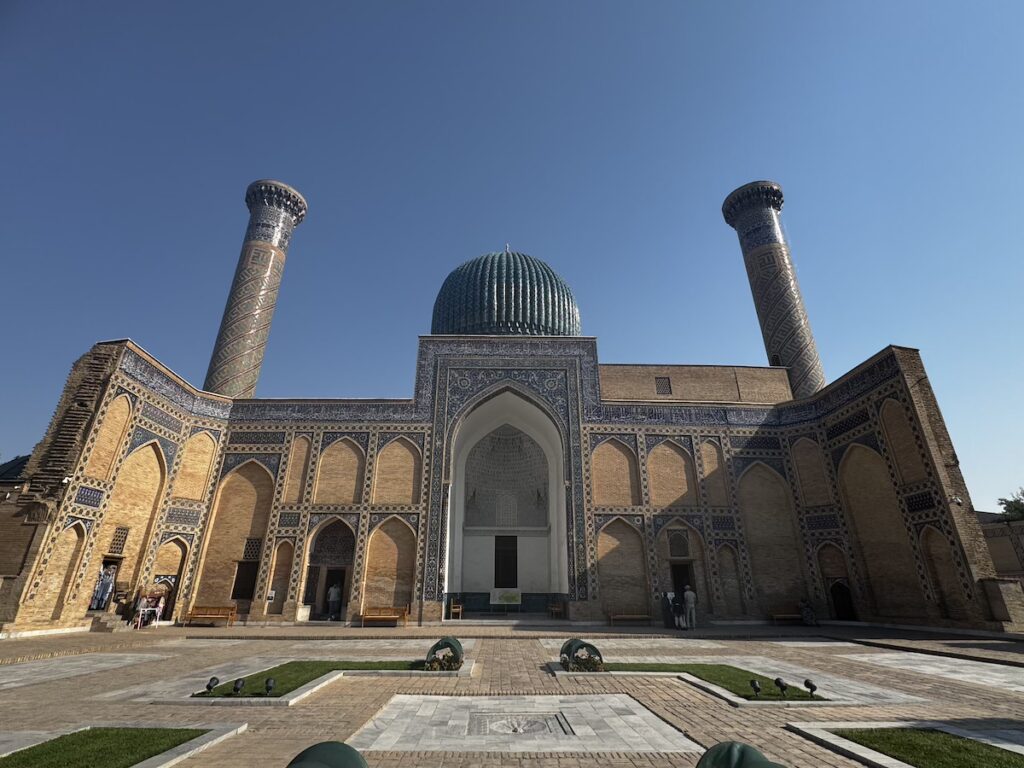
When I arrived in Samarkand, it truly felt as though I was stepping into legend, my feet treading on almost sacred ground. I travelled at the peak of summer, and the heat was stifling… Samarkand lies in the desert, after all. Coming straight from the cool mountains of Kyrgyzstan, the contrast was sharp. With temperatures up to 45°C and no lower than 36°C even at night, I knew I would have to adapt my pace to the climate. But I was determined to make the most of it, and set out for three wonderful days in a city of turquoise mosaics, fascinating, multi-layered history, and more than 2,500 years of heritage.
Here is my itinerary for 3 days in Samarkand: a journey through cultural treasures, moments of wonder at the royal heritage of the Timurids, and my favourite discoveries.
- Day 1 – First Encounters with Timur’s Legacy
- Day 2 – Travelling Back in History
- Day 3 – From the Stars to Eternity
- Where to eat in Samarkand
- Samarkand: Practical Information
Day 1 in Samarkand – First Encounters with Timur’s Legacy
On this first day, I stayed close to my guesthouse in Samarkand’s Old Town, right by Bibi Khanym Mosque. And honestly, I didn’t need to go far — the area was already full of wonders to explore. Within easy walking distance, I could immerse myself in blue-tiled monuments, wander the bustling Siyob bazaar, and end the day at the majestic Registan.
Bibi Khanym Mosque: a Legendary Monument of Imperial Ambition
As I was staying right next to Bibi Khanym Mosque, it made sense to start there. I was excited to begin with such an iconic landmark, already living up to all my expectations of shimmering blue mosaics. As soon as I entered (no need to cover your head here), I was greeted by a young guide who offered me a tour for about 5 USD. I gladly accepted — a bit of historical background, especially at the start of my trip, felt invaluable.
She explained that while many believe Amir Timur built the mosque for his wife, that wasn’t actually the case: it was meant to be the main mosque of Samarkand, a grand symbol of Timurid power, after the leader returned from his Indian campaign. I later found out that many legends surround the building of this mosque: some say it was ordered by “bibi-khanym”, Timur’s favourite (or eldest?) wife, and others say it involved a romance between said wife and the architect who was commissioned with building the mosque in the absence of Timur.
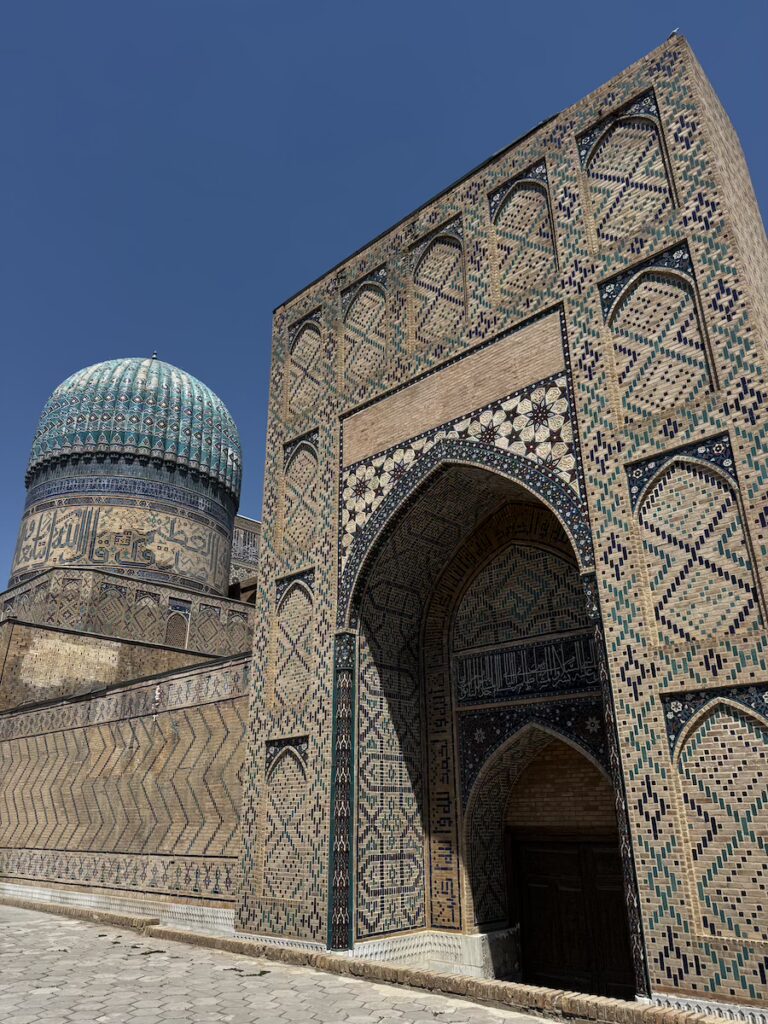
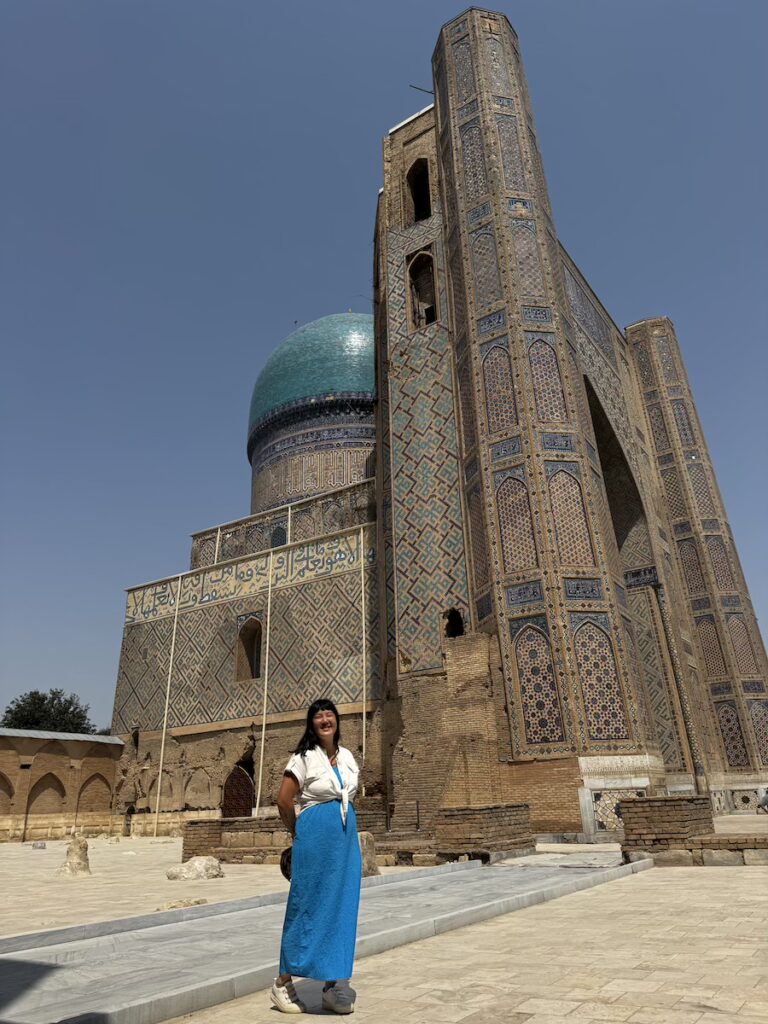
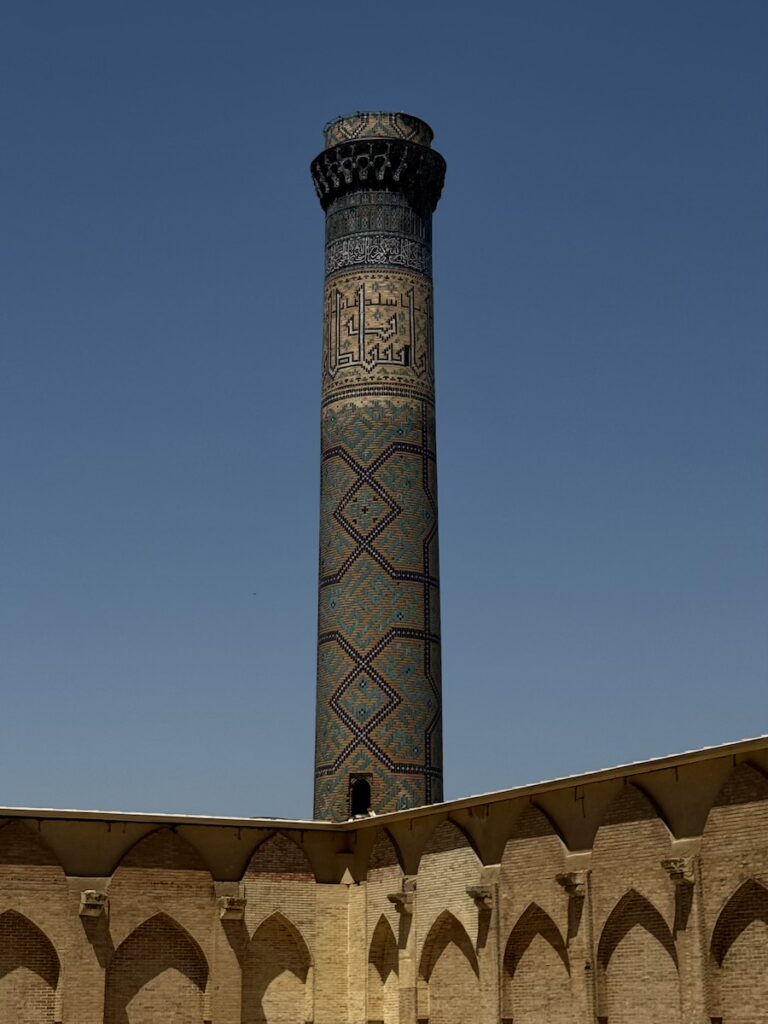
Anyhow, the mosque was so ambitious that over time it couldn’t even bear its own weight, collapsing little by little. Over the centuries, much of the building suffered from earthquakes, and the portals in particular are no longer as tall as they once were. Restoration work, especially under the Soviets, preserved some of the towers and portals we can admire today but it is no longer a place of worship.
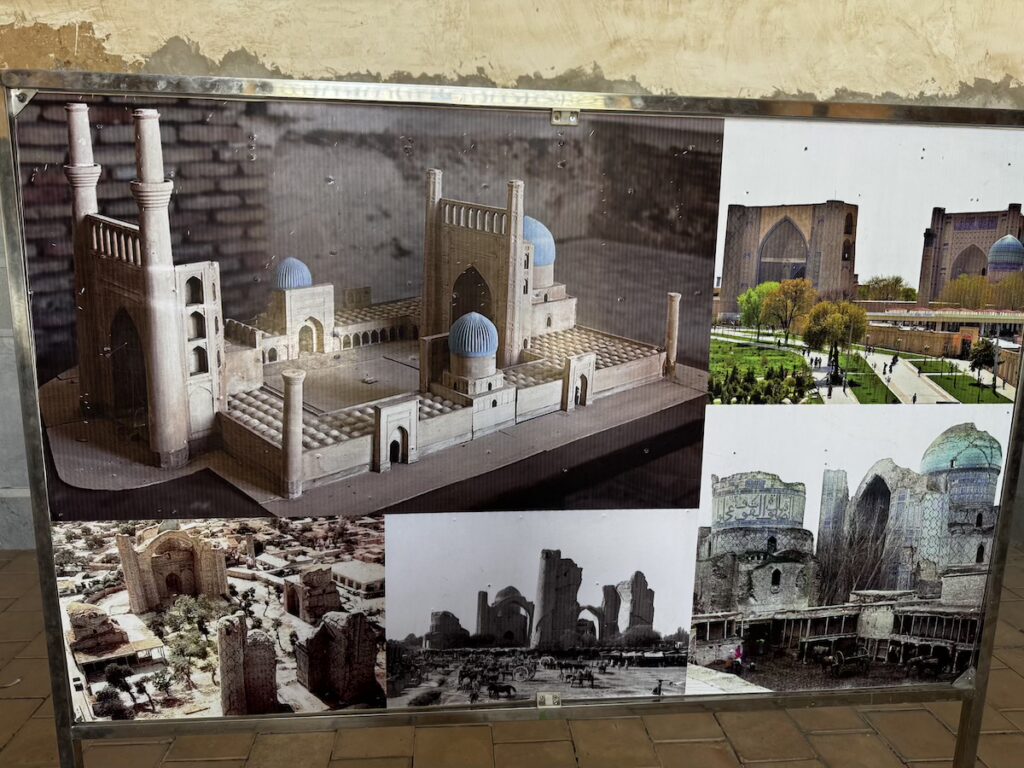
Inside one of the three remaining buildings, you can see archival pictures showing the mosque through the ages. On one of them, the scene is particularly striking: bustling activity all around, with a caravanserai (for merchants and travellers) and a bazaar nearby (not where the Siyob Bazaar stands today, but its ancestor).
Entrance fee (2025): 60,000 UZS
Siyob Bazaar: spices, saffron and daily life
Just nearby lies the Siyob Bazaar, which continues the tradition of markets that always flourished around major religious sites. This is something I’ve noticed across cultures, from Uzbekistan to Japan: temples and mosques were never only places of worship, but also centres of community life.
Don’t miss the various alleys of this market. It has everything, from saffron to mountain tea, from seasonal fruits (fresh and dried) to everyday groceries. It’s a colourful, instructive walk, though expect to be called out by sellers in every alley! That’s part of being a visitor here!
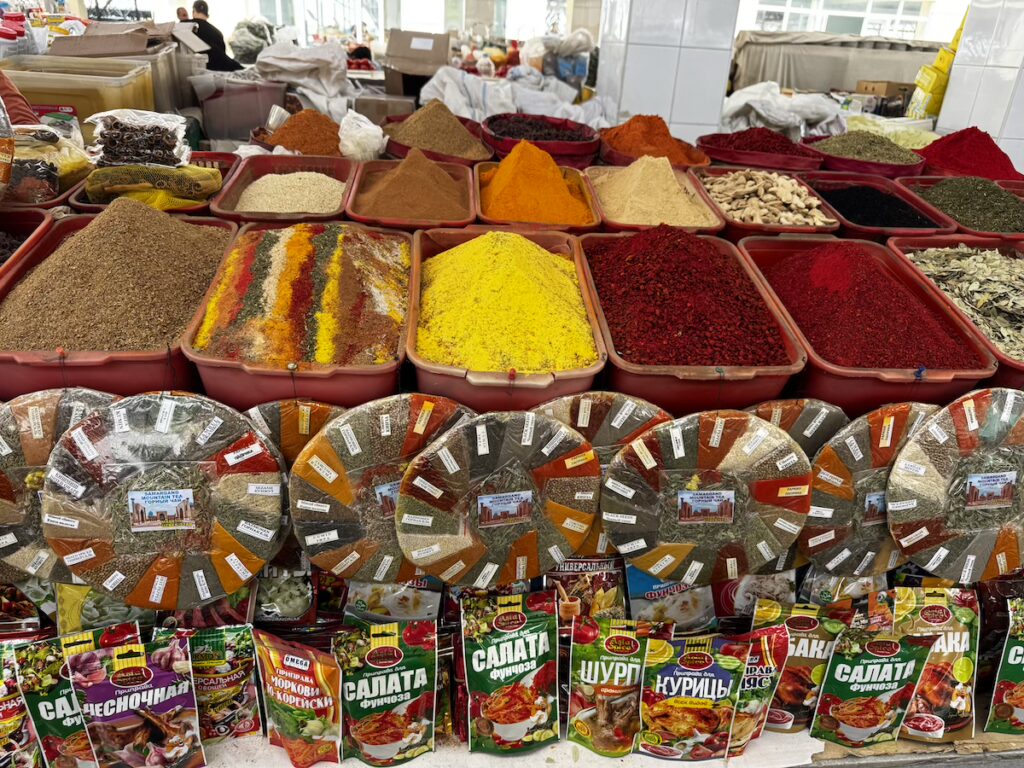
I bought saffron and a spice “wheel” to bring home for family and friends, all at very good prices. You’ll also see ceramics and fabrics, but if you’re heading on to Bukhara, I recommend waiting for a wider selection there.
Registan square, the Heart of Timurid Samarkand
This is Samarkand’s highlight, of course. Because of the heat, I decided to adopt a split rhythm for sightseeing in Uzbekistan: heading out early in the morning, returning to my guesthouse during the hottest hours, and venturing out again around 5 or 6pm. So after a restorative nap at my wonderful guesthouse (details at the end of this article), I set off to see the Registan.
Well, if there’s one place you must see with your own eyes, this is it. The square is framed by three madrasas (Islamic schools, both secular and religious):
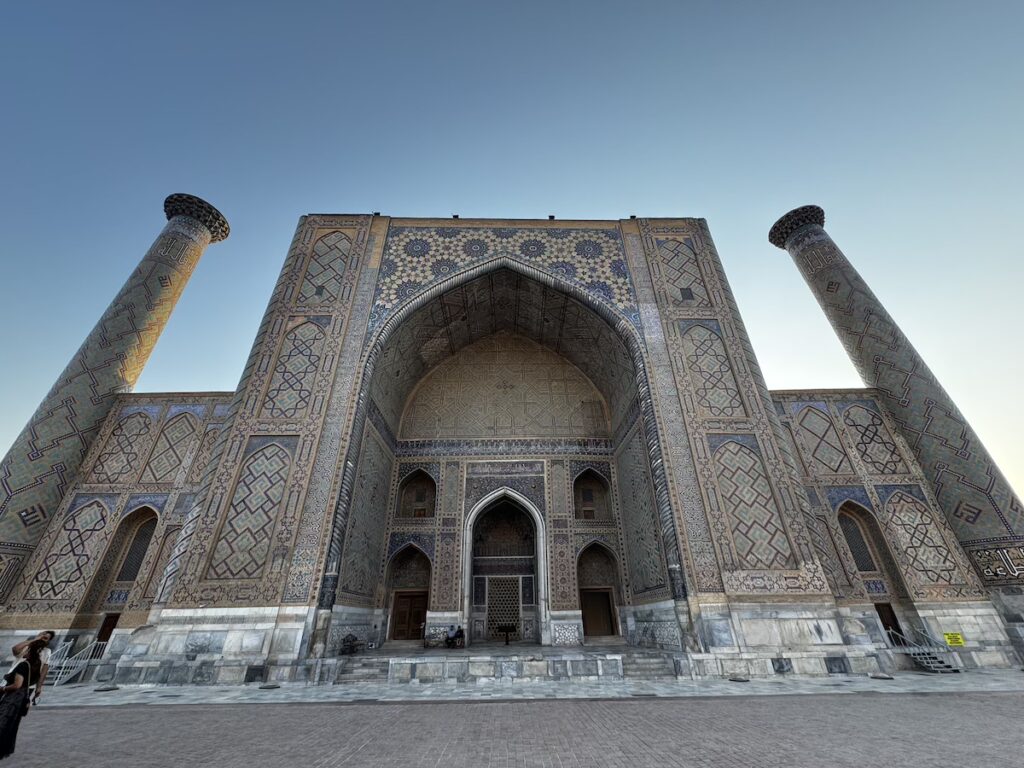
Ulugh Beg Madrasa (15th century), on the left as you face the square, recognisable by its starry portal. I suppose this is a nod to Ulugh Beg’s passion and genius for astronomy. Note that his observatory is now a museum in the city, we will head there on another day.
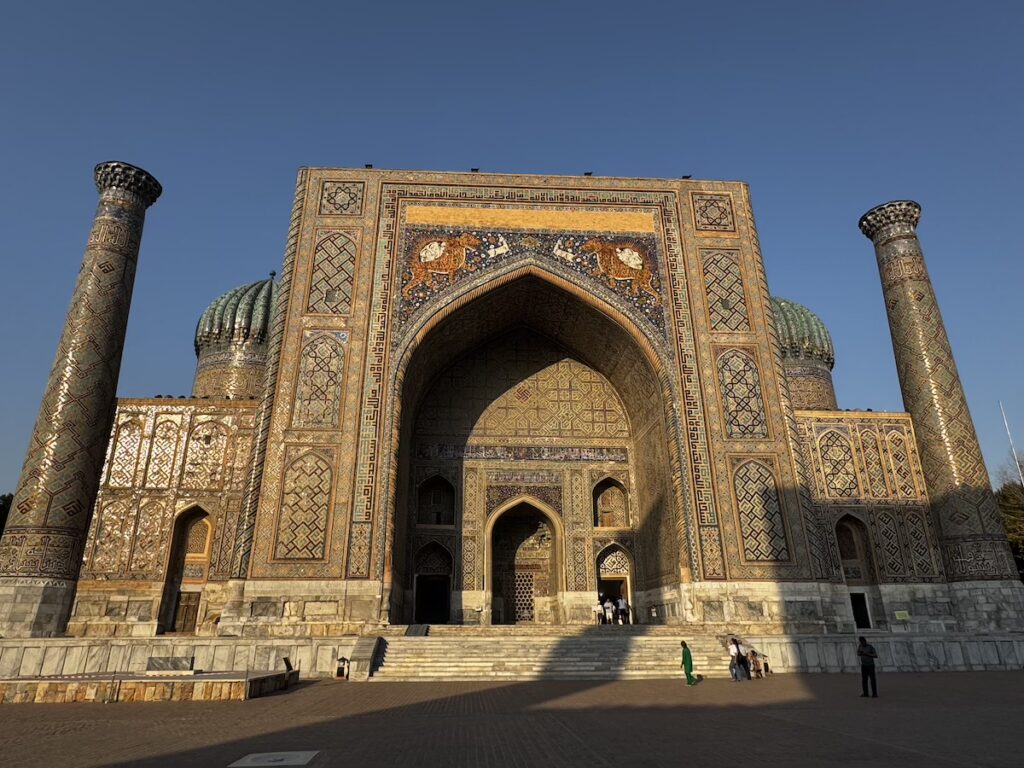
Sher Dor Madrasa (start of 17th century), on the right, its name meaning “with lions” (though they look more like tigers). These golden felines have become enduring symbols of Samarkand, found everywhere in local crafts and souvenirs.
And finally the Tilya-Kori Madrasa (17th century), the central building, which also served as a mosque when Bibi Khanym was in ruins.


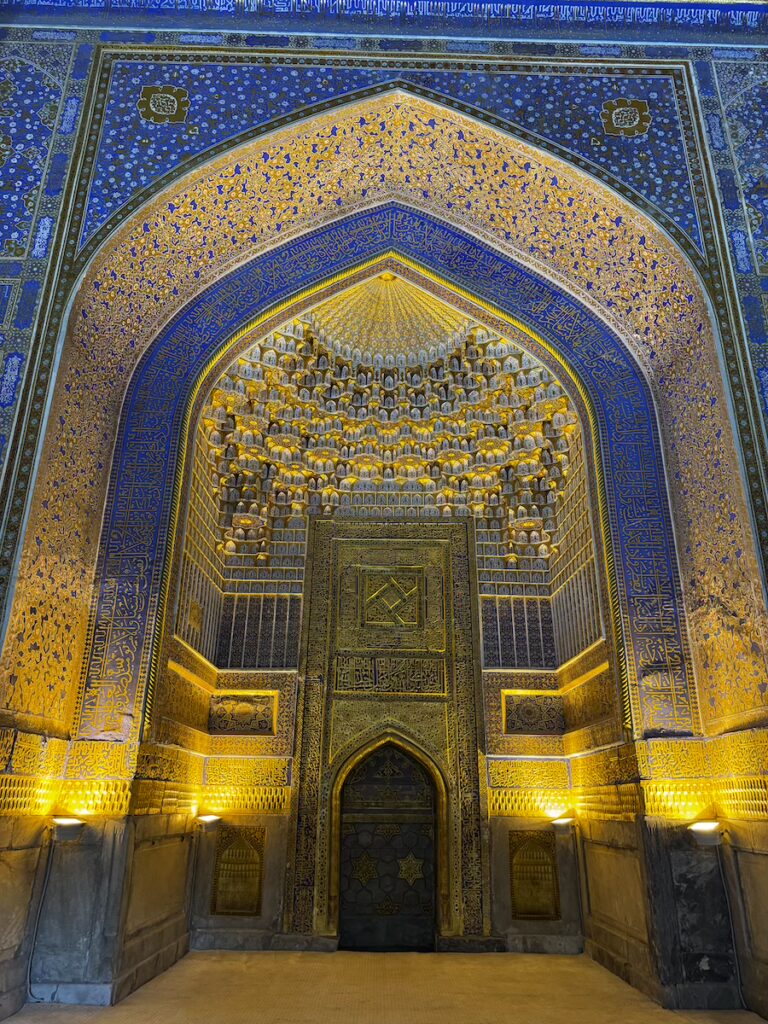
The courtyards are peaceful and spectacular, some with restored domes covered in breathtaking details of sculpture and painting. I spent hours there, strolling slowly, inspecting details, letting myself be immersed in the magnificence. If, like me, you enjoy observing architecture and sculpture up close and savouring beauty, plan at least two hours here.
Entrance fee (2025): 100,000 UZS
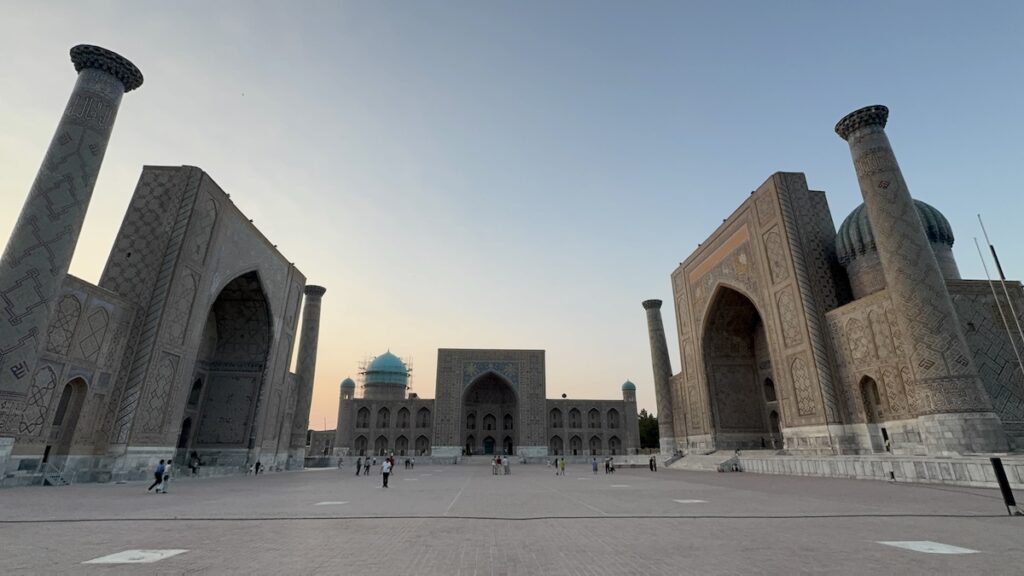
Samarkand by night: shashliks and family strolls
In the evening, I enjoyed late shashliks (see here my short selection of restaurants in Samarkand) and strolled along Tashkent Road, near the park east of Registan Square. Families with children were out enjoying the slightly cooler night air. Not the same country at all, but it reminded me of evenings by the lake in Hanoi when I lived in Vietnam, and felt wonderfully nostalgic.
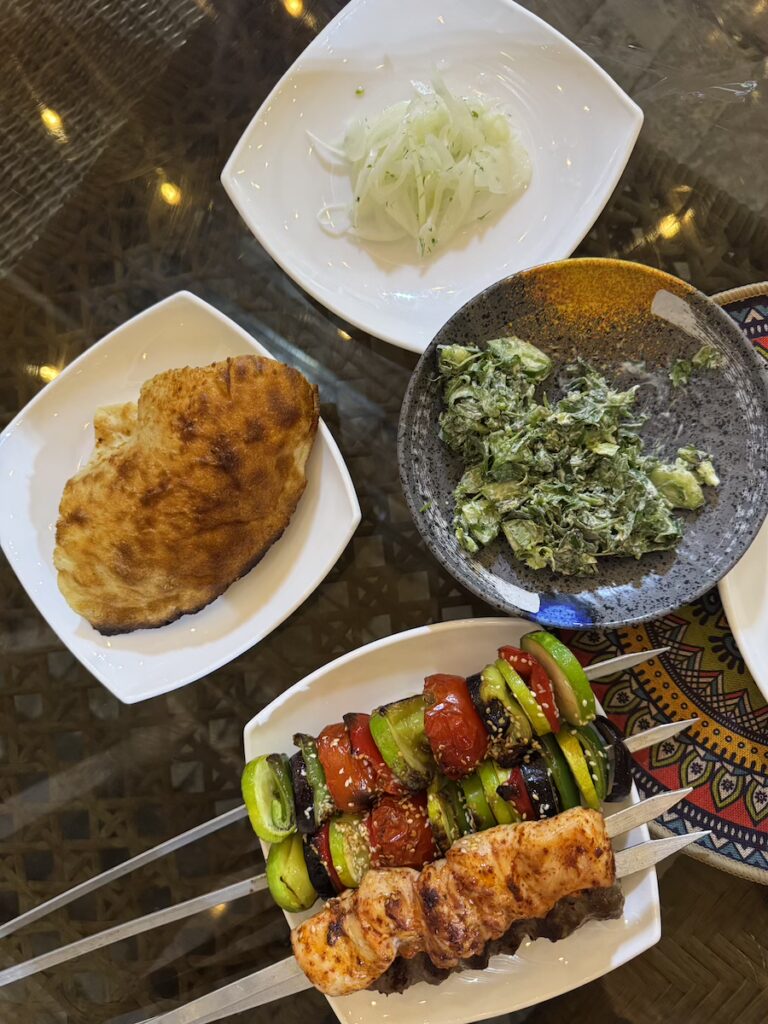
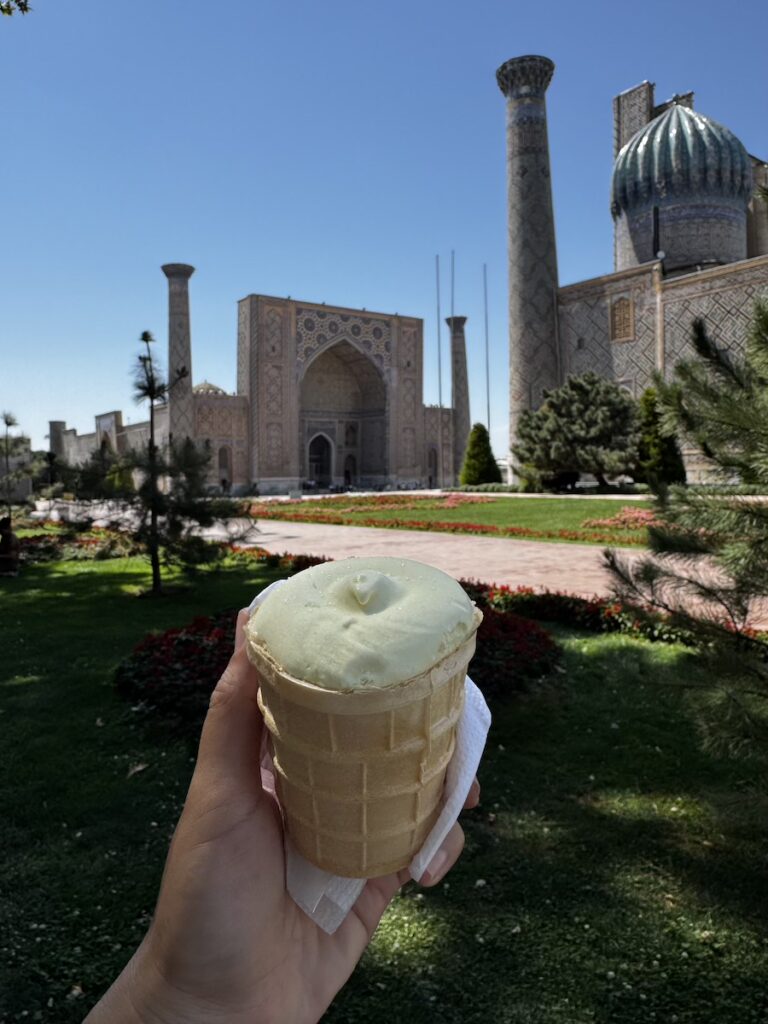
It’s also the perfect time for ice cream: there’s a great gelato shop right in front of the Registan… and to blend into local life under the glow of the city lights.
Day 2 in Samarkand – Travelling Back in History
On my second day in Samarkand, I was determined to continue my quest for turquoise mosaics, a style initiated by Amir Timur, the admired Timurid leader, and one that would become so characteristic of Central Asia.
To be fair, trying to grasp the history of architecture in Samarkand when you know nothing about the region is a bit like being sent down a rabbit hole. I’ll try to make it as clear and succinct as possible in this guide, but I can only encourage you to read a few books to better understand how important these monuments are in the history of the continent.
Gur Emir, under the Turquoise Dome
My day began at the Gur Emir Mausoleum. It was originally built by Amir Timur’s grandson and appointed successor, Muhammad-Sultan, who had been trained as the future king. Sadly, he died during a campaign before his grandfather, and in his name, Timur had a beautiful mausoleum built to bury him. Only a few years later, in 1405, Gur Emir became Timur’s own resting place as well.
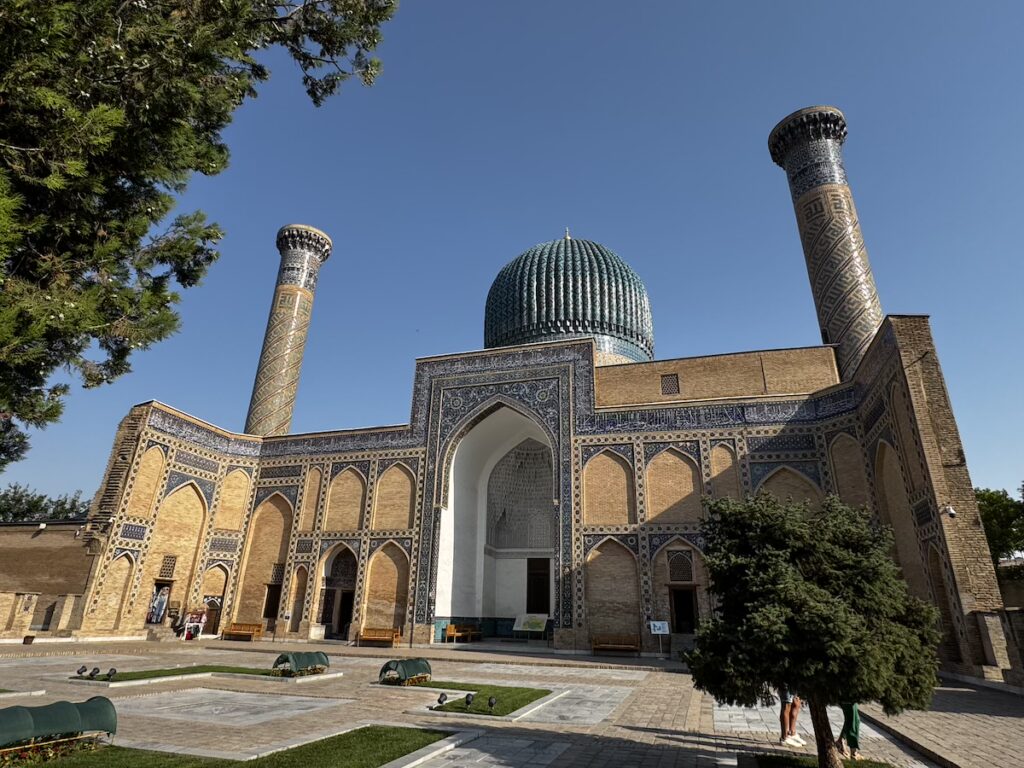
From the outside, its turquoise dome rises like a beacon, with 64 folds representing the number of years the Prophet Muhammad lived. Inside, the golden ceiling is one of the most beautiful things you will see in Samarkand. Several tombs are visible, as the mausoleum also shelters other Timurid princes. Mirzo Ulugh Beg, Timur’s grandson and successor, is also buried here.
This building is crucial in the history of Persian architecture. Gur Emir would later inspire Mughal architecture in India — echoes of it can be traced all the way to the Taj Mahal.
Entrance fee (2025): 70,000 UZS
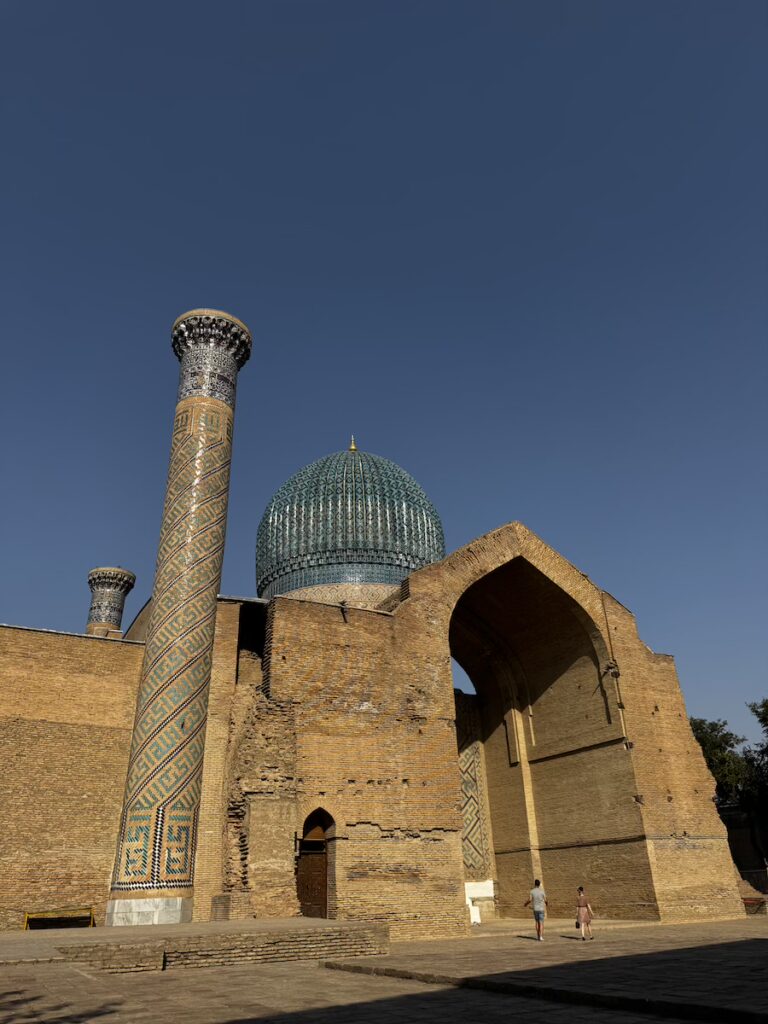
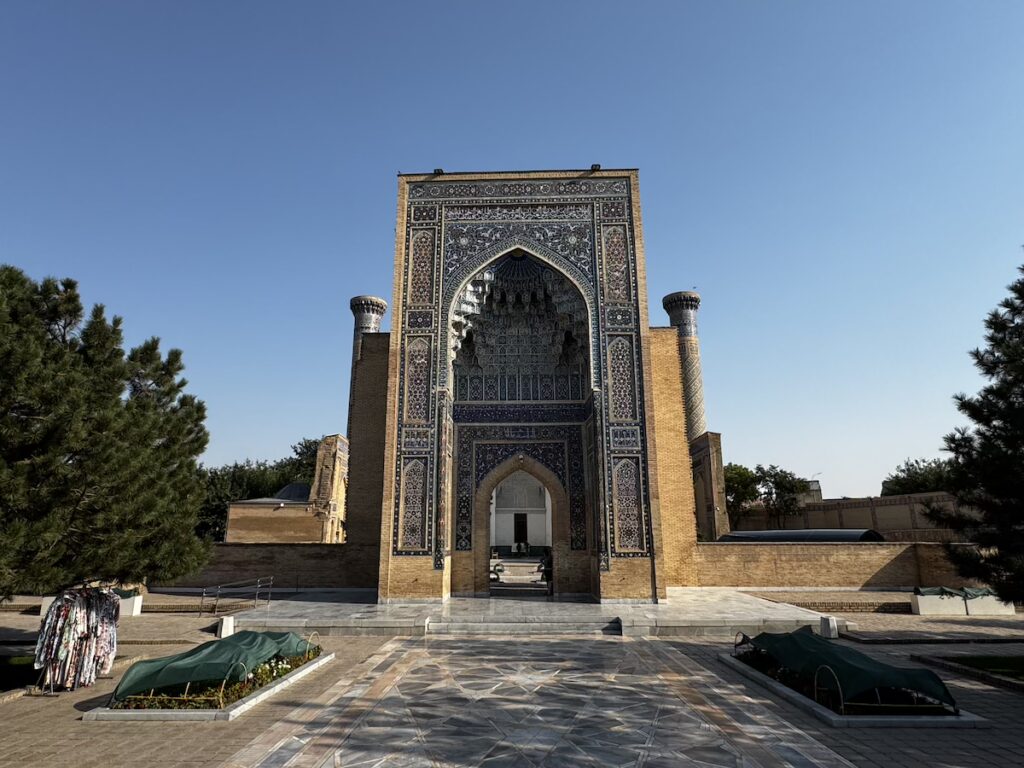
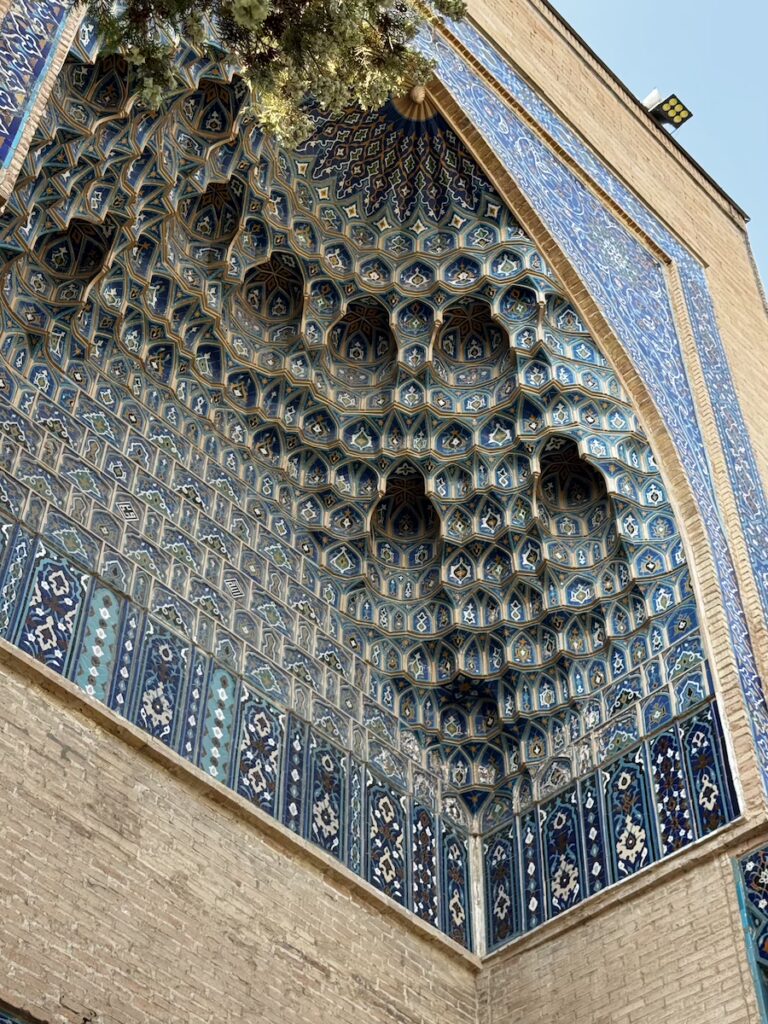
If you’d like to know more about the Timurids and Amir Timur, the beloved founding figure of Uzbekistan, have a look at my Tashkent article, where I touch upon who he was.
Aksaray Mausoleum, the White Palace
Just behind the imposing Gur Emir lies a far smaller, often overlooked structure: the Aksay Mausoleum (the “white palace”). It is believed to be the last family mausoleum built by the Timurids in the second half of the 15th century, though there are many theories as to who is actually buried there.
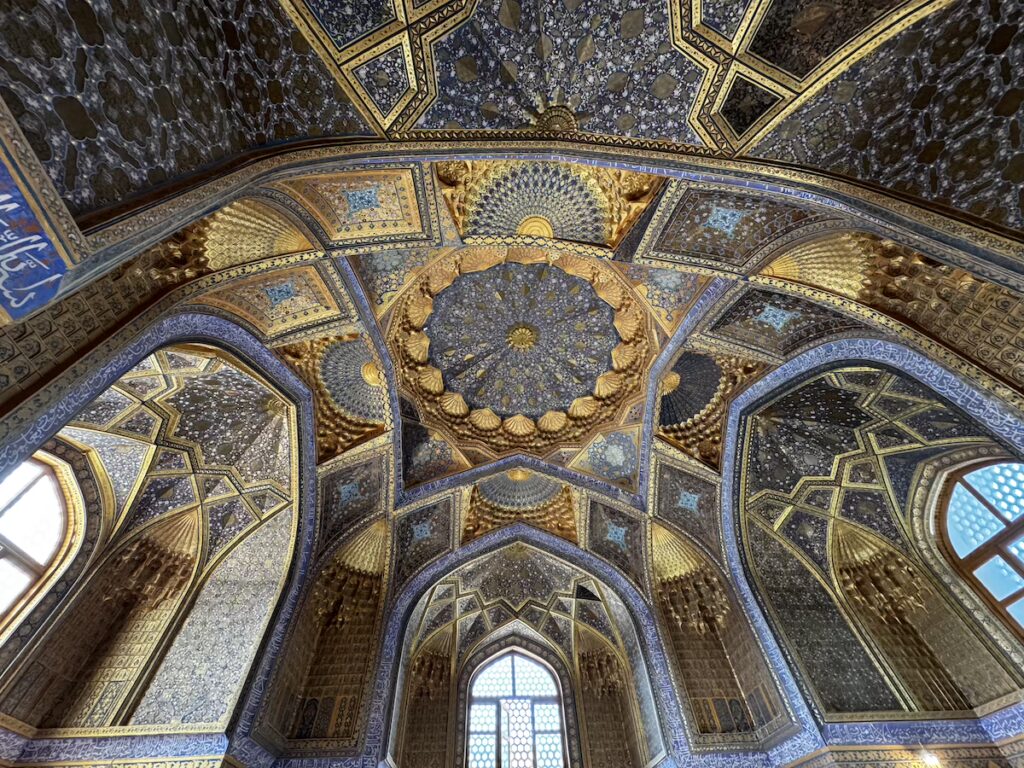
From the outside it looks like nothing special, but the dome ceiling inside is worth the small entrance fee. The guard was incredibly friendly, happy to take photos for me, and even encouraged me to stay as long as I wanted. Compared to other sites this isn’t a spectacular building, but its quietness made it memorable. You can also descend into the underground octagonal crypt, where two tombs are visible. The high stairs and stone details give a real sense of the craftsmanship of the time.
Entrance fee: 10,000 UZS
Hazrat Khizr, the Mosque of Travellers
In the afternoon, I climbed to the Hazrat Khizr Mosque, perched on a hill with sweeping views across Samarkand. Unlike the monumental madrasas and Gur Emir, this mosque feels intimate and alive, with locals coming to pray.
Also known as the Mosque of Travellers, it was built on the remains of a Zoroastrian temple, destroyed when Islam became the dominant religion in the region. Hazrat Khizr, who gives the mosque its name, is a mythical figure believed to be an eternal wanderer, revered as a protector of travellers and merchants.
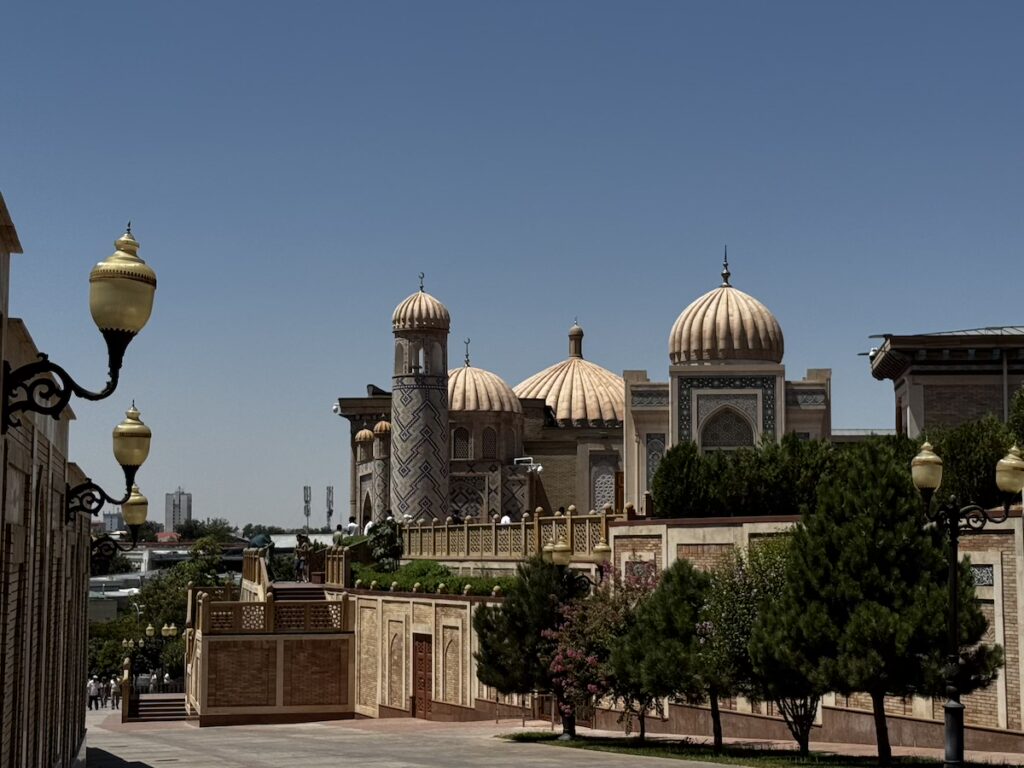
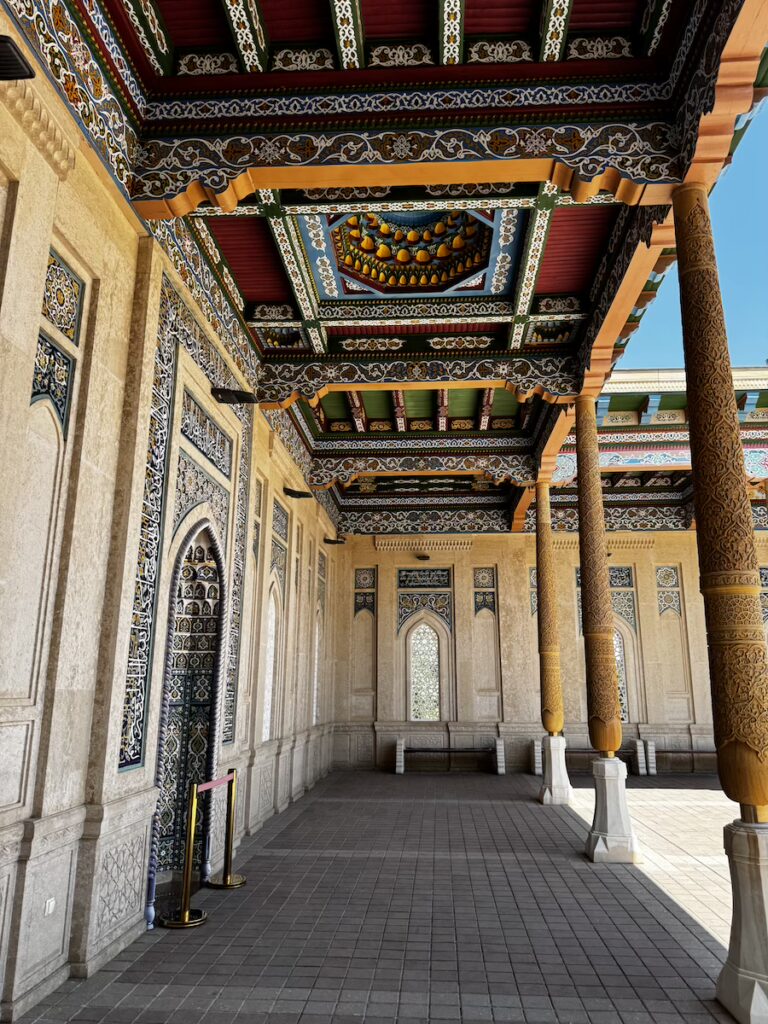
Afrosiyab Museum: Unearthing the Ancient City
So far I had been immersed in Timur’s legacy, but Samarkand existed long before him. The best place to explore this earlier history is the Afrosiyab Museum, located on the city’s heights.
Afrosiyab refers to what remained of the city prior to the Mongol invasions of the 13th century, and is believed to date back as far as the 6th–7th century BC. The museum lays this history out chronologically, with objects of daily life unearthed from the site. I particularly liked how the curators placed each discovery in the context of archaeological work, making you aware not just of the objects themselves, but of the process of uncovering them.
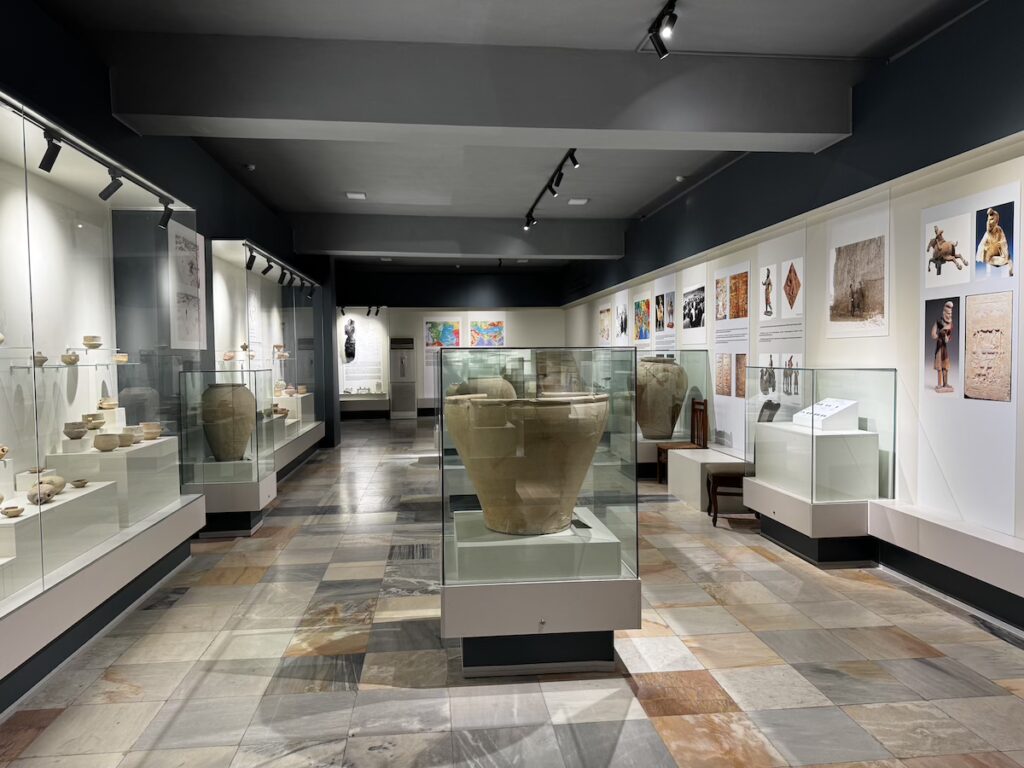
The museum’s highlight is without doubt the 7th-century mural known as the Ambassadors’ Fresco. Spanning three walls, it depicts ambassadors, hunting scenes and processions. The fact that this immense artwork travelled through centuries to reach us today, thanks to careful excavation and restoration, left me in awe.
Entrance fee (2025): 40,000 UZS
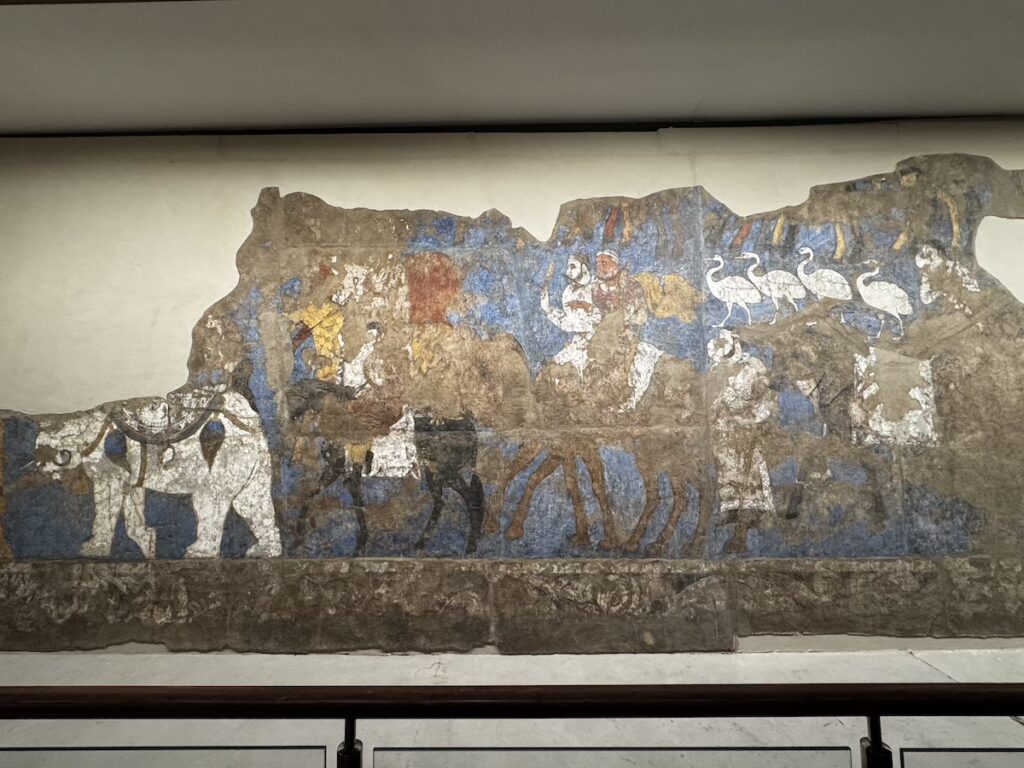
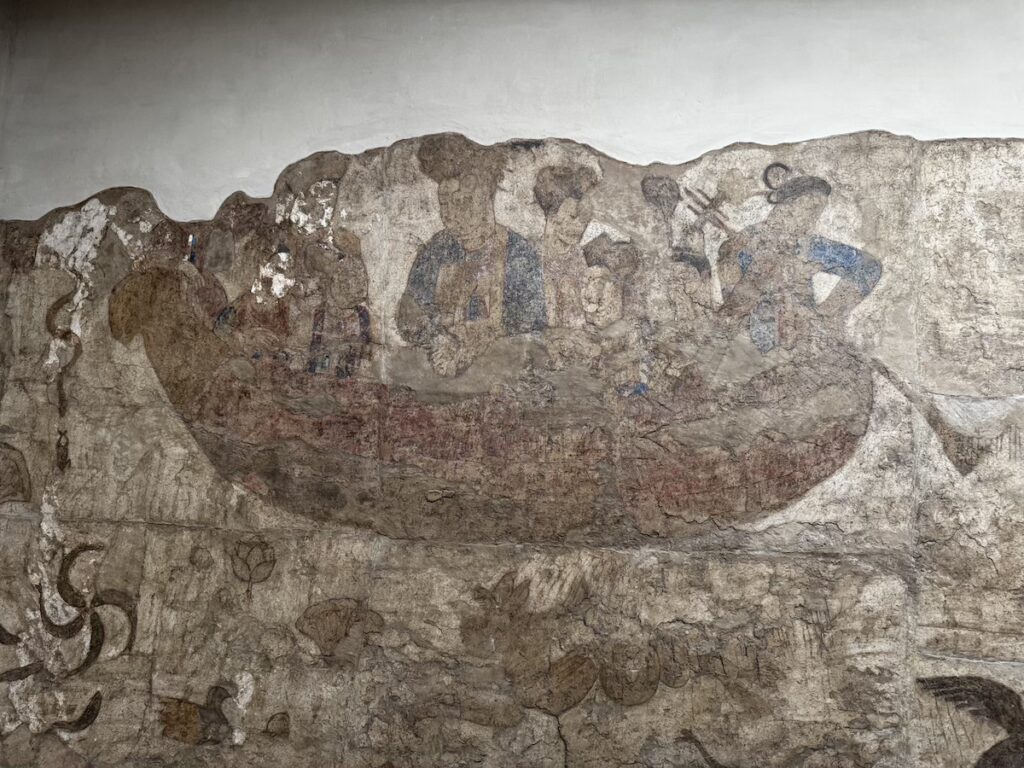
The Registan’s Night Lights
The night illuminations of the Registan are breathtaking, so if you have the chance, don’t miss them. Unfortunately, I didn’t manage to see them that night. Either they weren’t turned on, or more likely, I simply didn’t wait long enough. Tired and without reliable information, I left earlier than I should have. But having seen so many wonders already, I felt no regret.
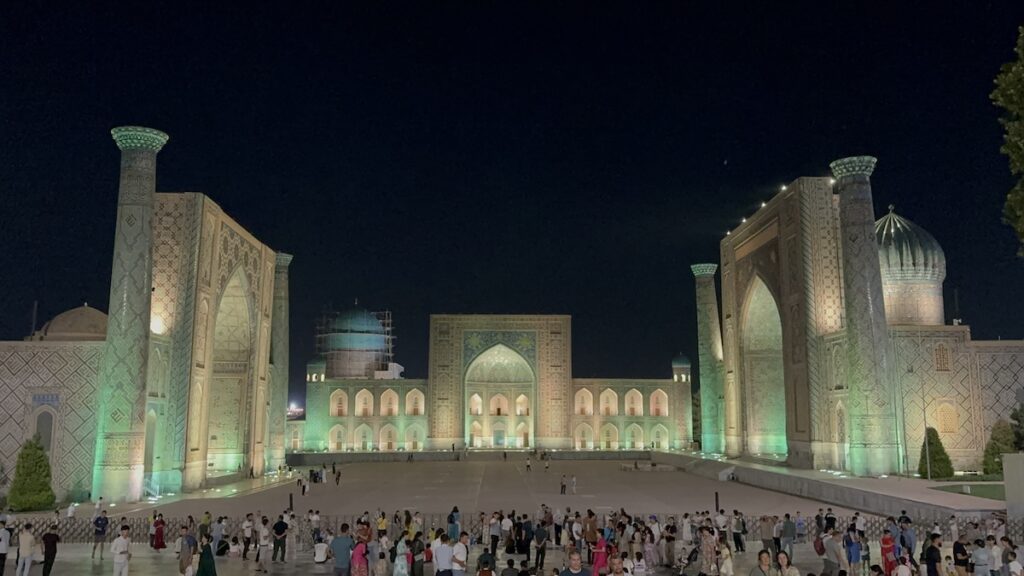
As I walked back through the quiet streets that night, I felt that the day had carried me through centuries. Every step had felt like a dialogue between past and present and I knew these impressions would stay with me long after I left the city. But another last day was waiting for me!
Day 3 in Samarkand – From the Stars to Eternity
Ulugh Beg Observatory: Measuring the sky
My last morning in Samarkand was dedicated to science. While Timur’s legacy is carved in stone and mosaics, his grandson Mirzo Ulugh Beg left his mark in the stars. The observatory this ruler-scholar built in the 15th century was among the most advanced in the world, even though today only fragments of it remain.
I had come mainly to see the enormous stone sextant that once measured the heavens. To be honest, I didn’t realise how little of the original observatory survives. Almost nothing is left, and I would have struggled to picture it if I hadn’t seen a scale model earlier in Tashkent’s Museum of the Timurids.
But the place didn’t disappoint: the museum was fascinating, full of insights into Ulugh Beg’s astronomical work. I learnt how they studied the sky at the time, but also how knowledge travelled across regions. Chinese scholars and astronomers from distant kingdoms came here to study with Ulugh Beg — proof of Samarkand’s role as a hub of science as well as trade.
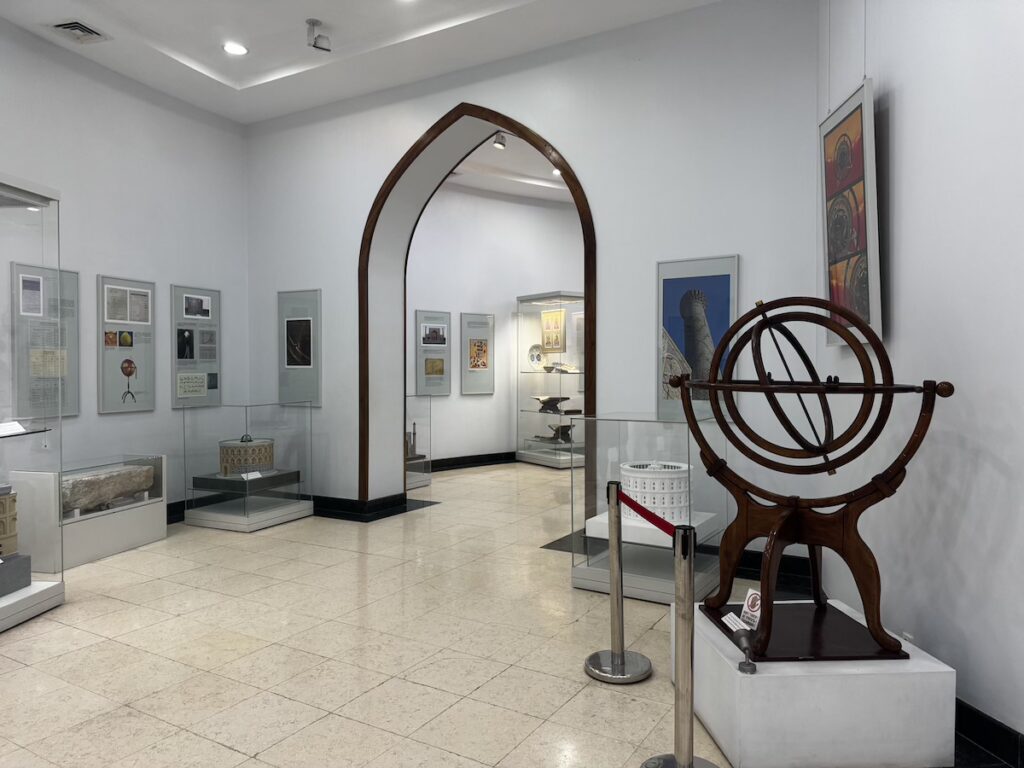
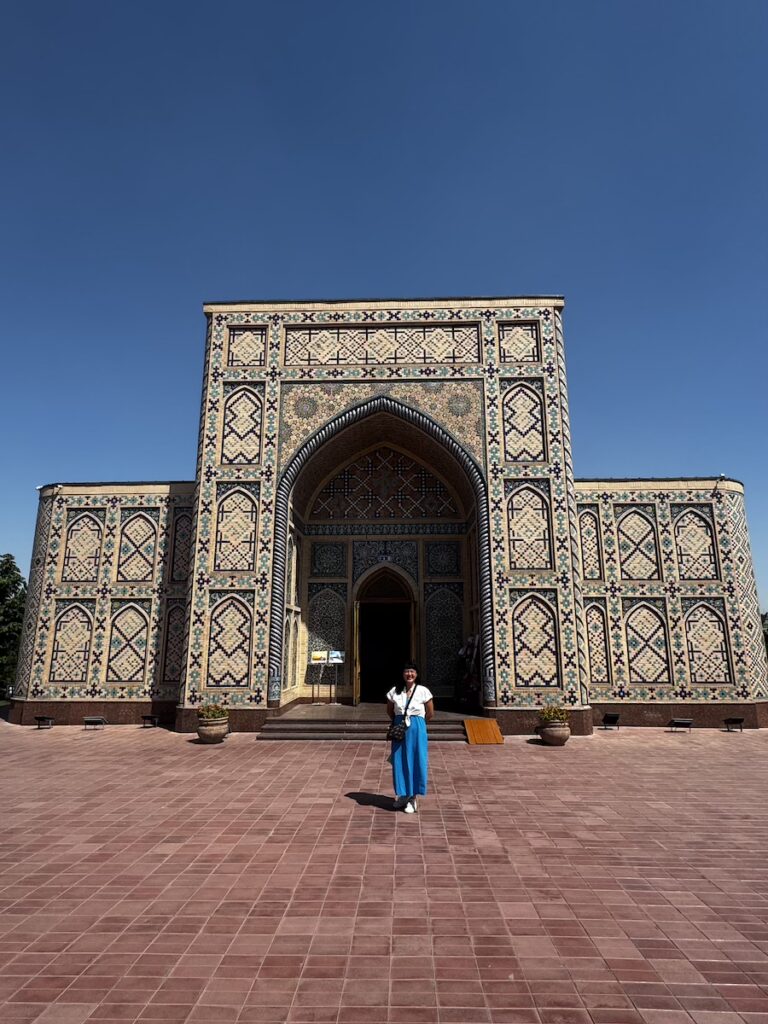
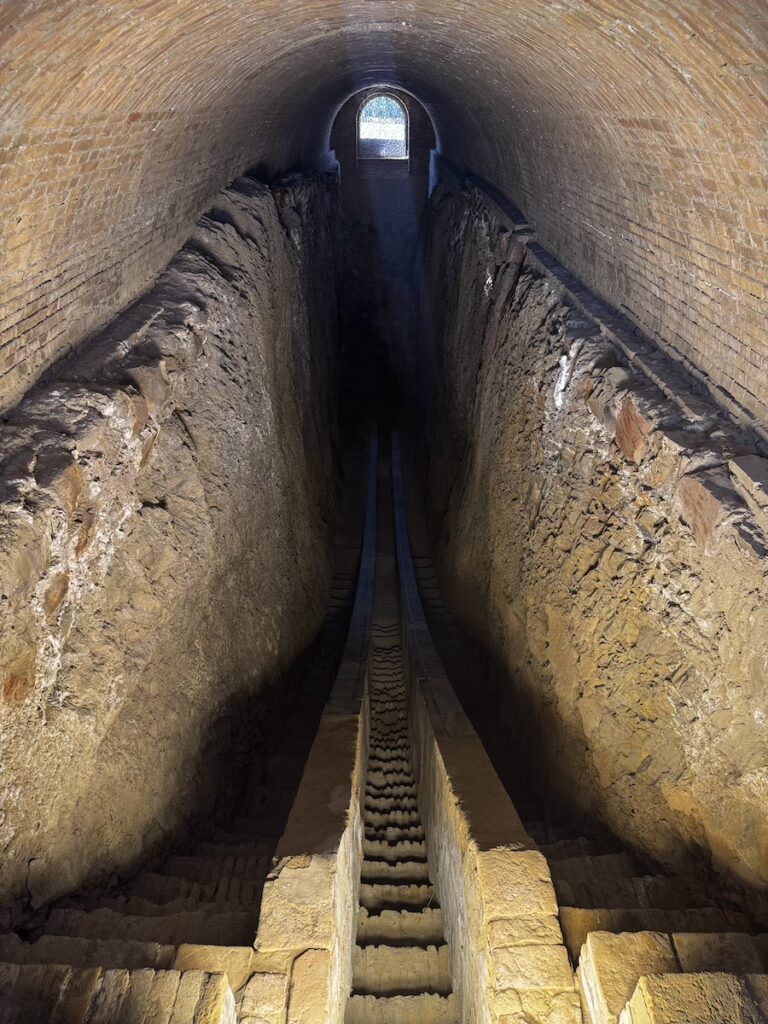
Entrance fee (2025): I actually can’t remember the entrance fee, but I think it was less than 40,000 UZS.
The House of Sadriddin Ayni, the Father of Modern Uzbek Literature
That day turned into a leap across centuries thanks to museums. In the afternoon, I visited the Sadriddin Ayni House Museum. I knew nothing about this writer before, but I had read that the house offered a good glimpse into a traditional Uzbek interior.
Ayni, often called the father of modern Tajik and Uzbek literature, lived here in the early 20th century. His works chronicled the struggles and spirit of his time, weaving together Central Asian identity under Soviet rule.
The museum is modest, and there are no English panels, but a virtual reality app provides short videos in English that you can play on your phone during your visit (this system is actually available throughout Uzbekistan, part of a national initiative for foreign visitors).
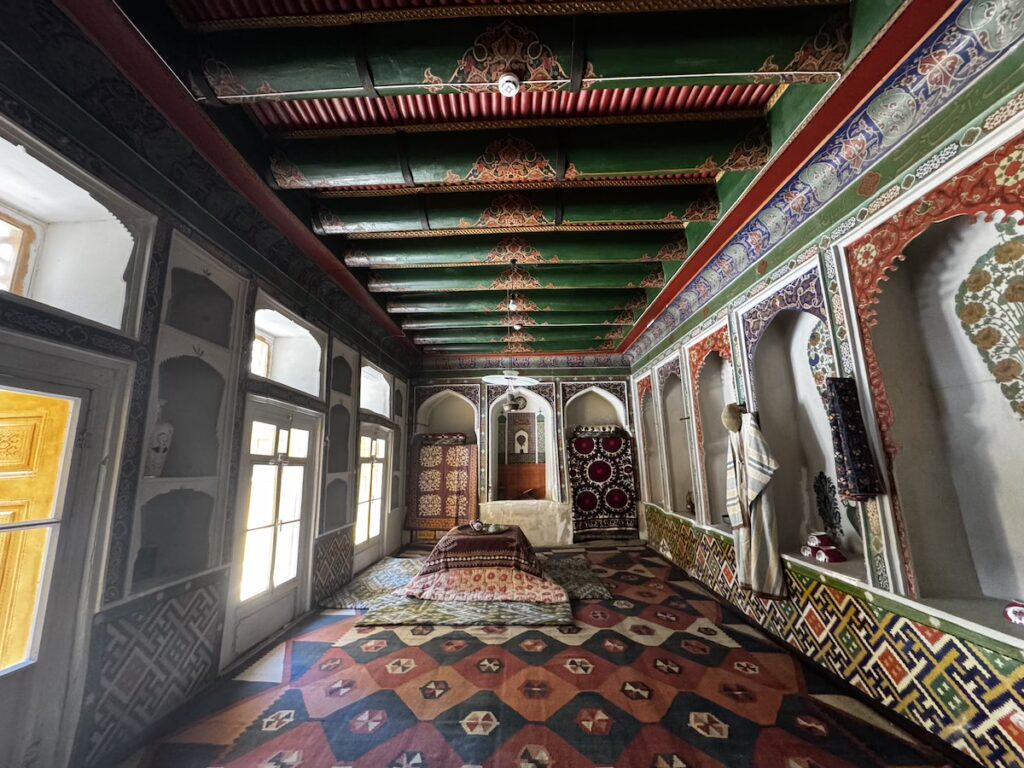
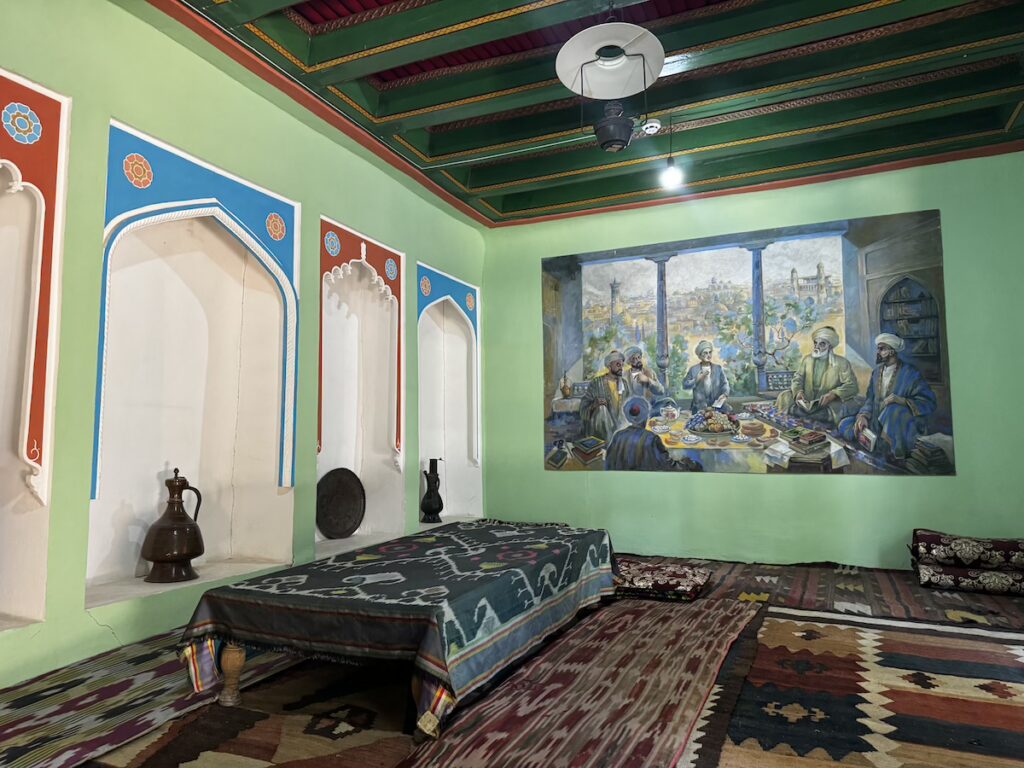
I am sure those who have read his books would appreciate the visit more deeply than I did. Still, it was interesting to step into something different after so much Timurid grandeur — and it wasn’t the end of my discoveries that day.
Entrance fee (2025): I also can’t remember how much that was (sorry!) but it was quite low.
Happy Bird Gallery & Uzbek Arts
A short walk away, the Happy Bird Art Gallery and the bigger house it belongs to gave me yet another perspective on Samarkand. Bright ceramics, embroidered textiles, delicate jewellery — a vibrant celebration of Uzbek craftsmanship, both traditional and modern. I loved the house itself, covered in greenery and feeling like a little oasis in the city.
I browsed the craft shops, chatted with artists and vintage sellers, and of course, couldn’t resist bringing home a small souvenir or two. My favourite were hand-painted miniatures, so meticulous that they felt almost unreal.
That said, if you’re heading to Bukhara afterwards, I’d recommend waiting to do most of your shopping there: you’ll find a much broader choice of traditional crafts.
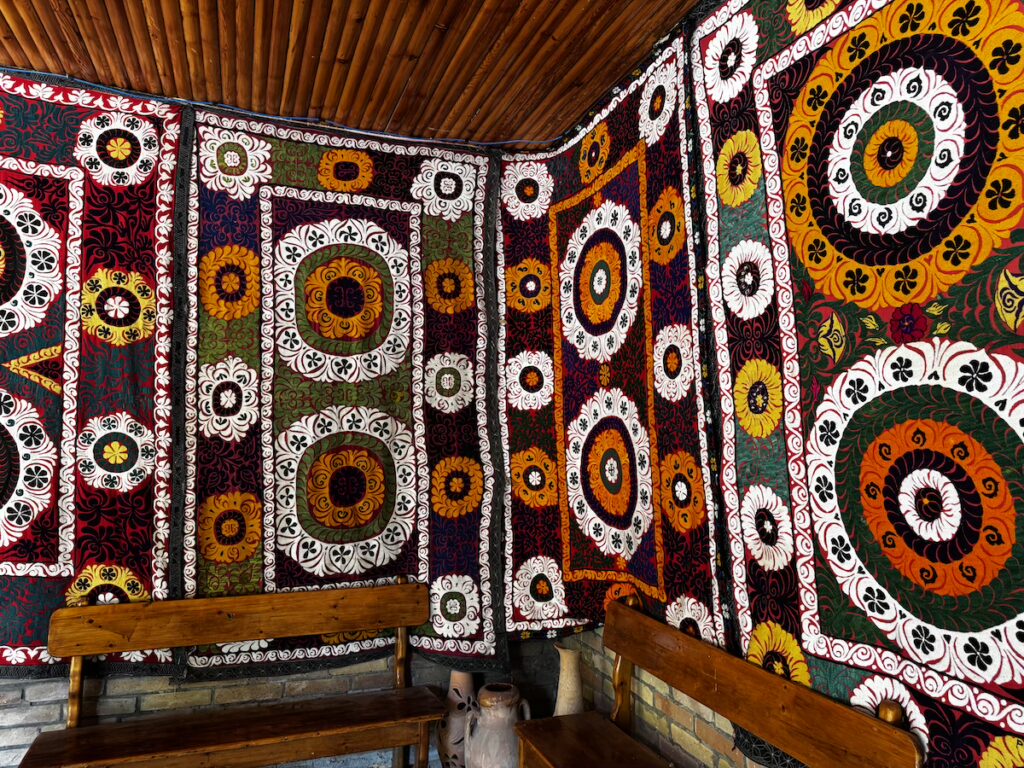
Shah-i-Zinda: on a Path of Turquoise Into Eternity
I saved the most extraordinary for last: the Shah-i-Zinda necropolis, a place I had been anticipating since the start of my trip. And even though I knew it would be extraordinary, nothing could have prepared me for the sheer beauty of this ensemble (almost looking like a small city!) of mausoleums.
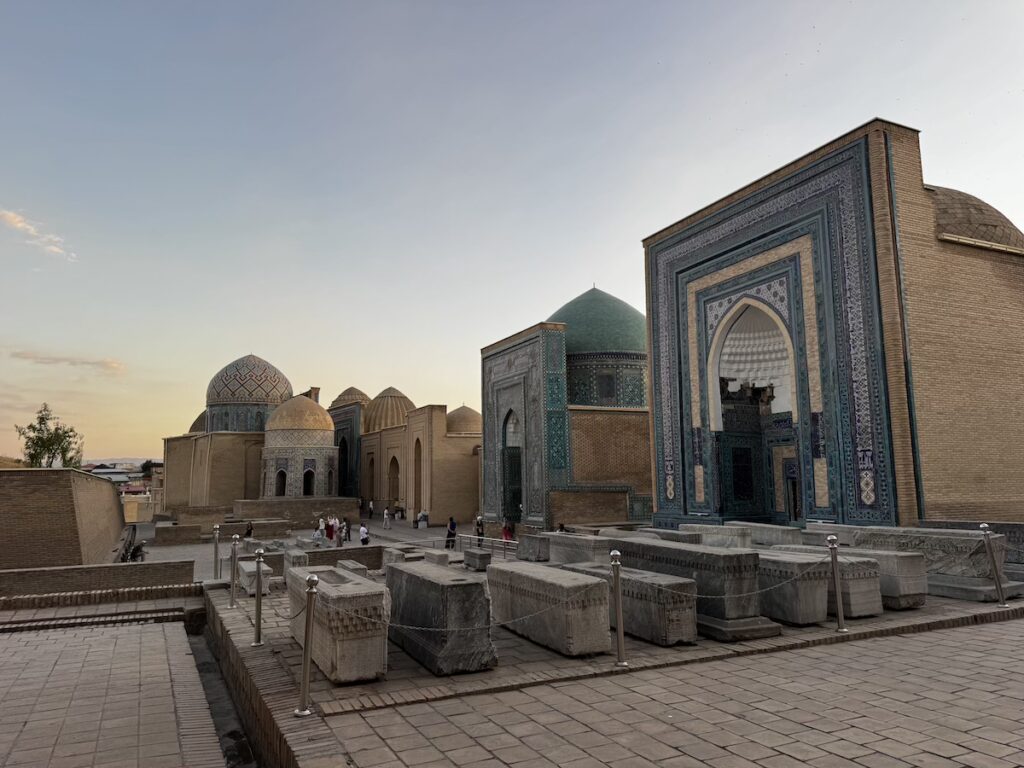
As the sun began to set, I climbed the stairs leading to this “palace of rest”. The alley of mausoleums glowed in shades of turquoise and cobalt, bathed in the last golden lights.
The name Shah-i-Zinda means “the Living King”, referring to Kusam ibn Abbas, cousin of the Prophet Muhammad, who was said to resemble him closely. Legend has it he was buried here after falling at the walls of Samarkand. The grave in the tomb that bears his name (to the right as you walk towards the northern ensemble) is much more recent than his supposed death, but the legend lives on. Don’t miss the memorial room nearby, richly decorated with intricate botanical patterns.
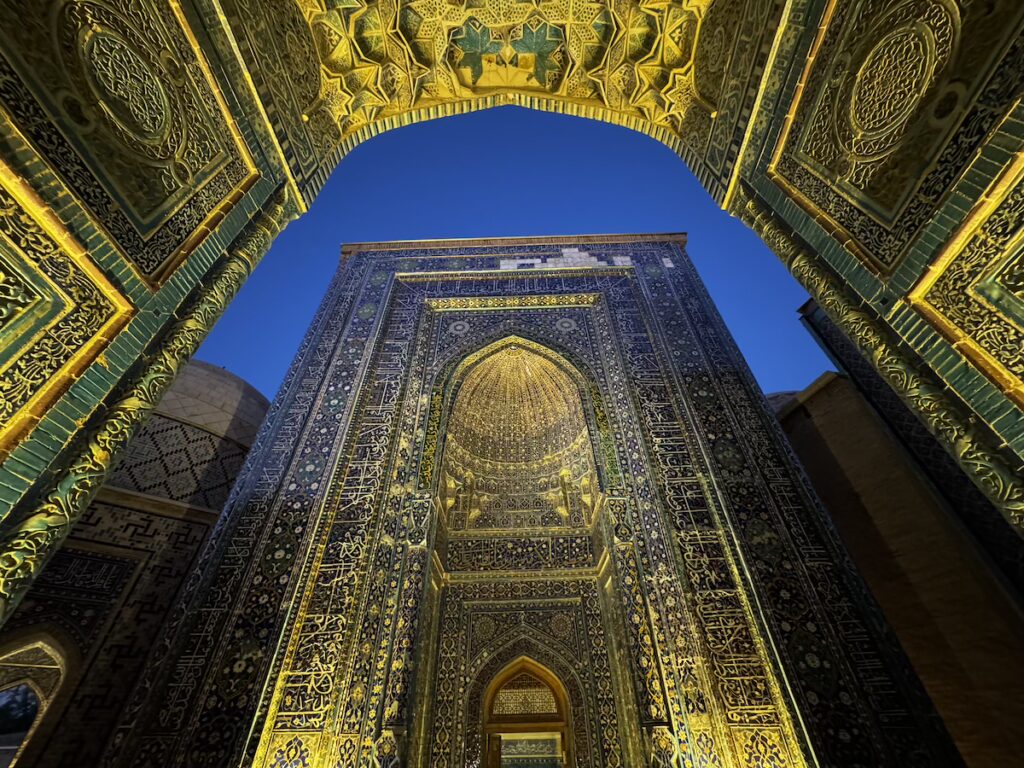
I wandered slowly, letting the dancing blues and deep silence sink in. When night fell, the mausoleums lit up, glowing softly in the darkness. The atmosphere was almost otherworldly. Without a doubt, it was the most moving moment of my stay in Samarkand!
I could spend pages describing the splendour of this place, but maybe I’ll save some for another story…
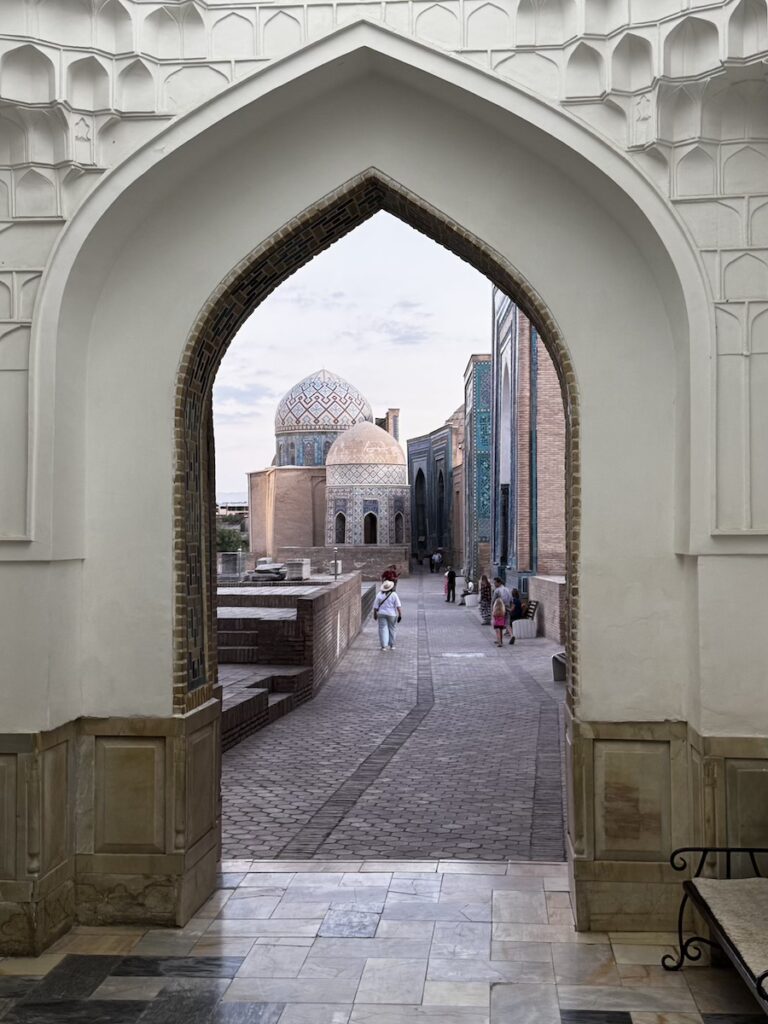
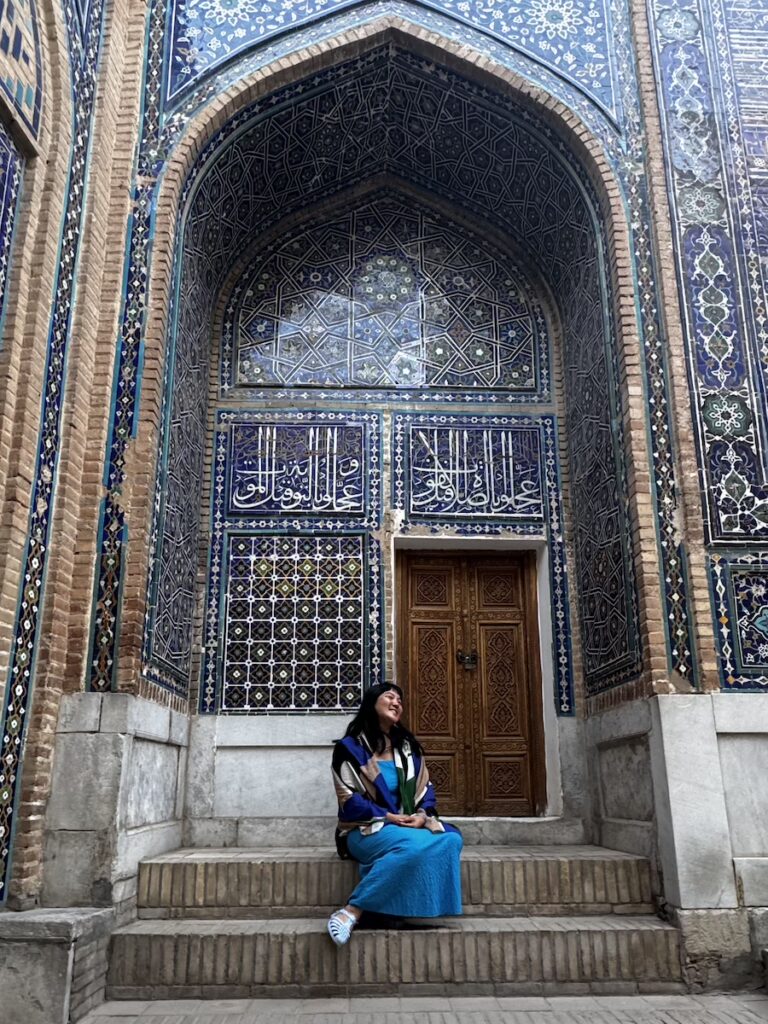
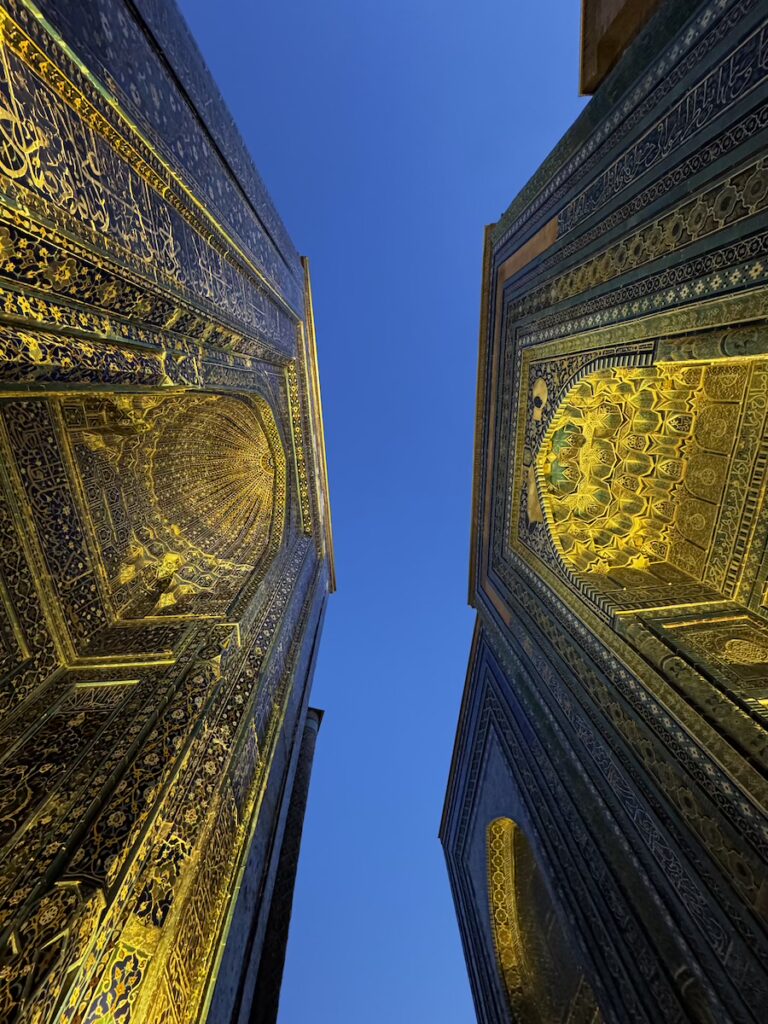
Samarkand’s Multiple Layers of Time
And so my journey through Samarkand came to an end! Three days of breathtaking architecture, science, spirituality and stories of empire: an experience of a lifetime.
Samarkand feels like a city you must enter layer by layer, where history and eternity blur. Its turquoise domes and ancient monuments will remain with me as beacons of beauty and grandeur.
I left with so many questions about how the city was built and rebuilt, about the passage of civilisations over and over again in the same place. My journey will continue at home, through books, research, and dreams of returning!
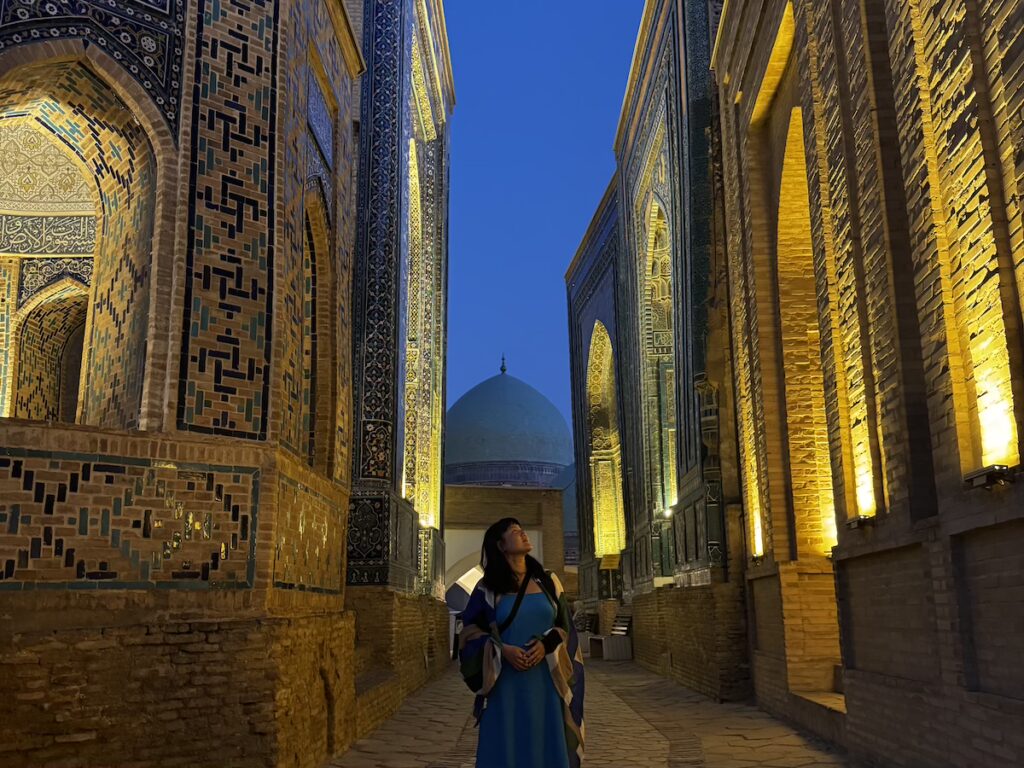
Where to eat in Samarkand?
Here are 3 restaurants and an ice cream place I enjoyed in Samarkand, where I also found the service was excellent:
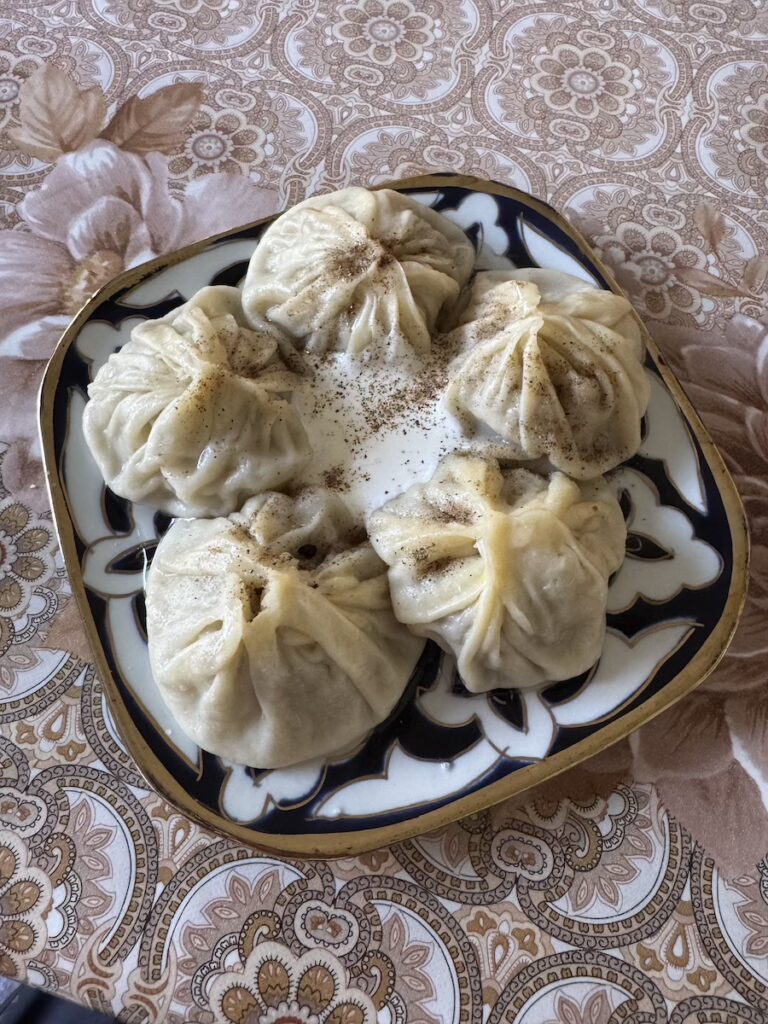
Café Bobur: a shashlik (kebab) place with a wide variety of meat and salads. It’s well-located behind Bibi-Khanym mosque and open until 11pm.
Manty Na Zakaz: a small canteen where the chef specialises in manty (dumplings). They are served with fresh yoghurt in Uzbekistan, which was quite a surprise and different from the ones I had in Kyrgyzstan previously. He doesn’t speak English, but will just serve you with the standard 5-dumpling plate.
Afandi Food: Right near the Happy Bird Gallery, this Mediterranean restaurant is more on the pricy side but I have excellent bread and baba-ganoush (aubergine cream).
Sogdiana Registan Cafe: Don’t miss an ice cream across the Registan. I fell in love with the small traditional ice cream in a short cone, but they also have a choice of gelati, looking delicious.
Samarkand: Practical Information
How many days?
Two full days will let you see the highlights, but three days allow you to take your time and soak in the atmosphere without rushing.
Best time to visit
Spring (April–May) and autumn (September–October) are ideal, with pleasant temperatures but also more crowds! Summer can be scorching in July and August (over 35°C even at night), so pace yourself with morning and evening visits if you go in summer, like I did.
Getting around
Most of the main sights in Samarkand’s Old Town (Bibi Khanym, Siyob Bazaar, the Registan, Shah-i-Zinda) are within walking distance.
For further spots (like Ulugh Beg Observatory), taxis are inexpensive and easy to arrange. Download the Yandex app, which is the local Uber/Grab. You can choose to either pay by card automatically or cash in the app. I found it the safest way to get around and not get ripped off by taxis.
Tickets & guides
Entrance fees are generally modest (a few USD). Hiring local guides at monuments can add a lot of context, especially for understanding the layers of history, but depending on the place, that can cost you up to 20 USD, at the Registan, for instance.
Where to stay in Samarkand?
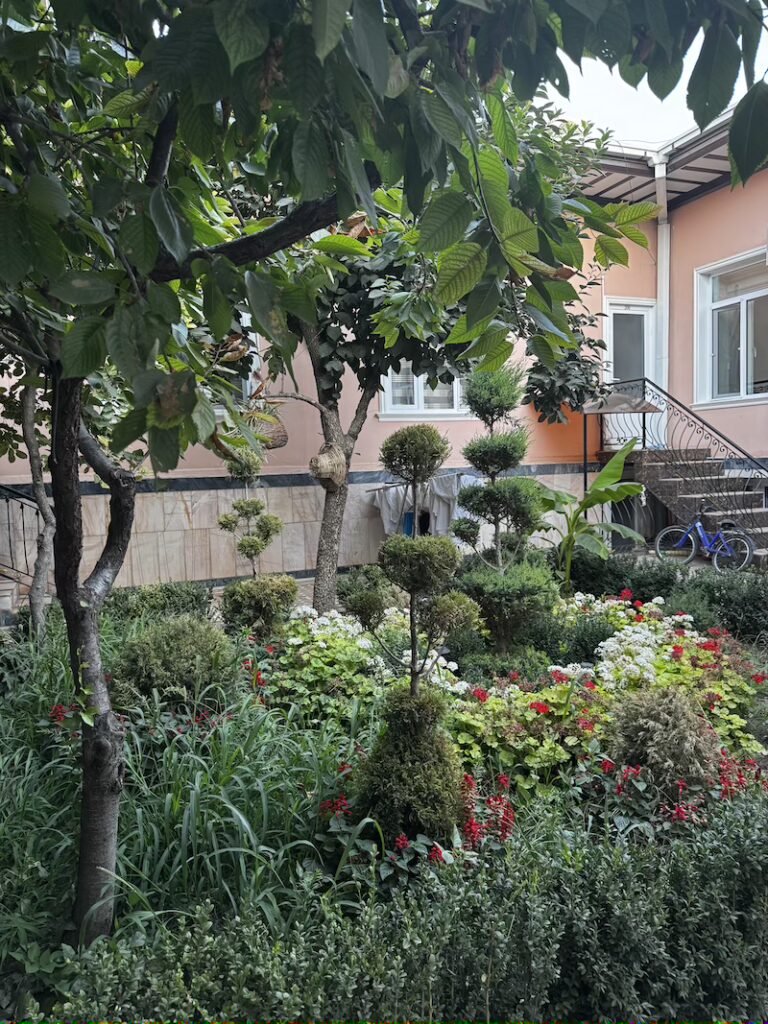
I stayed at the most lovely guesthouse of all, with an excellent location near Bibi-Khanym Mosque: Nursultan Grand Guesthouse. The house is fresh and has a lovely garden where it was pleasant to hang out and shelter from the heat.
Our host Dilnoza was extremely friendly, careful and helpful!
Shopping tips
You’ll find some crafts and souvenirs in Samarkand, but if you’re travelling on to Bukhara, save your shopping for there since the choice is much wider, and quality and prices often better.
Don’t miss
- Registan by day and illuminated at night.
- Shah-i-Zinda at sunset or, as a friend recommended to me, early in the morning
- A taste of Samarkand’s breads, dried fruits and spices at Siyob Bazaar.
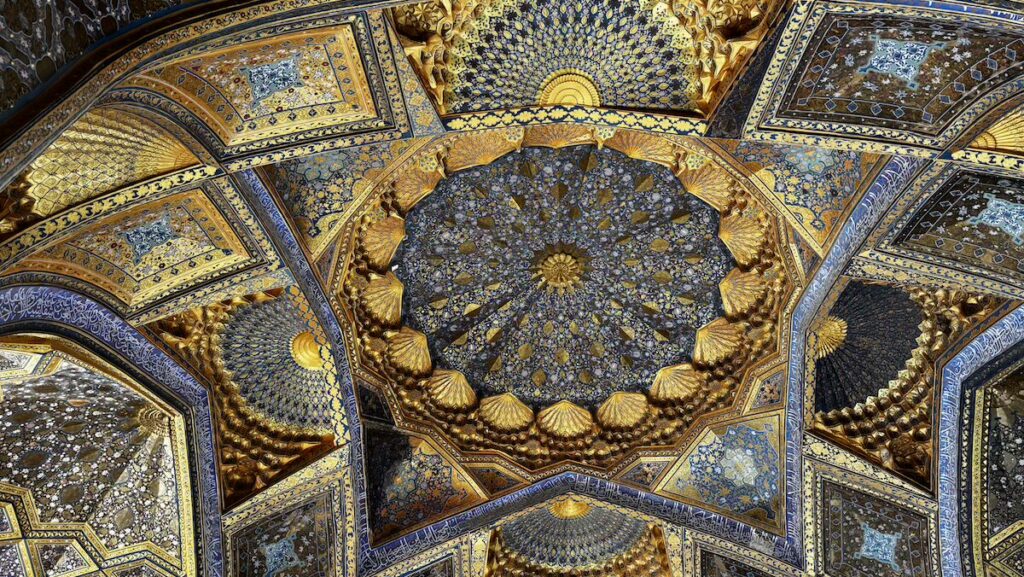

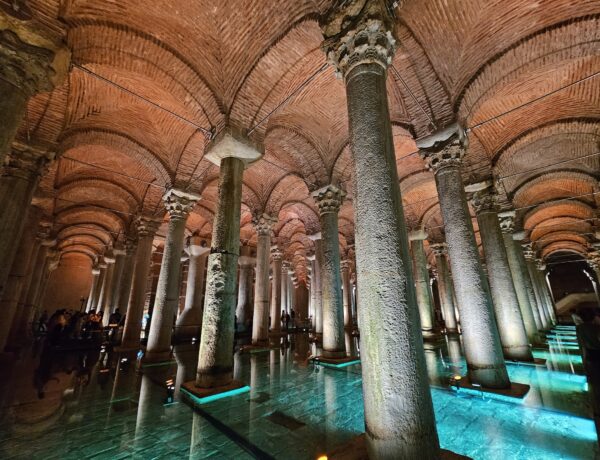
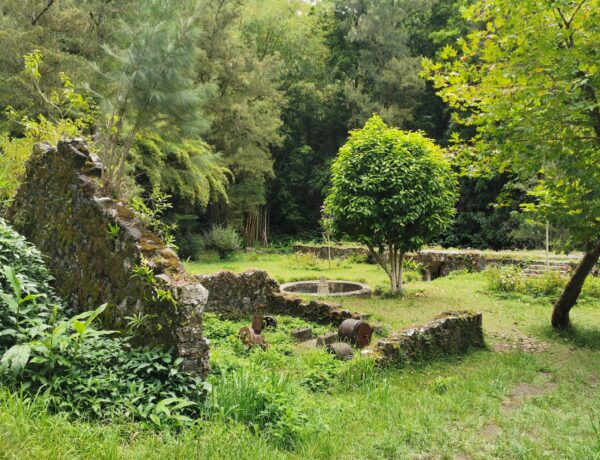
No Comments